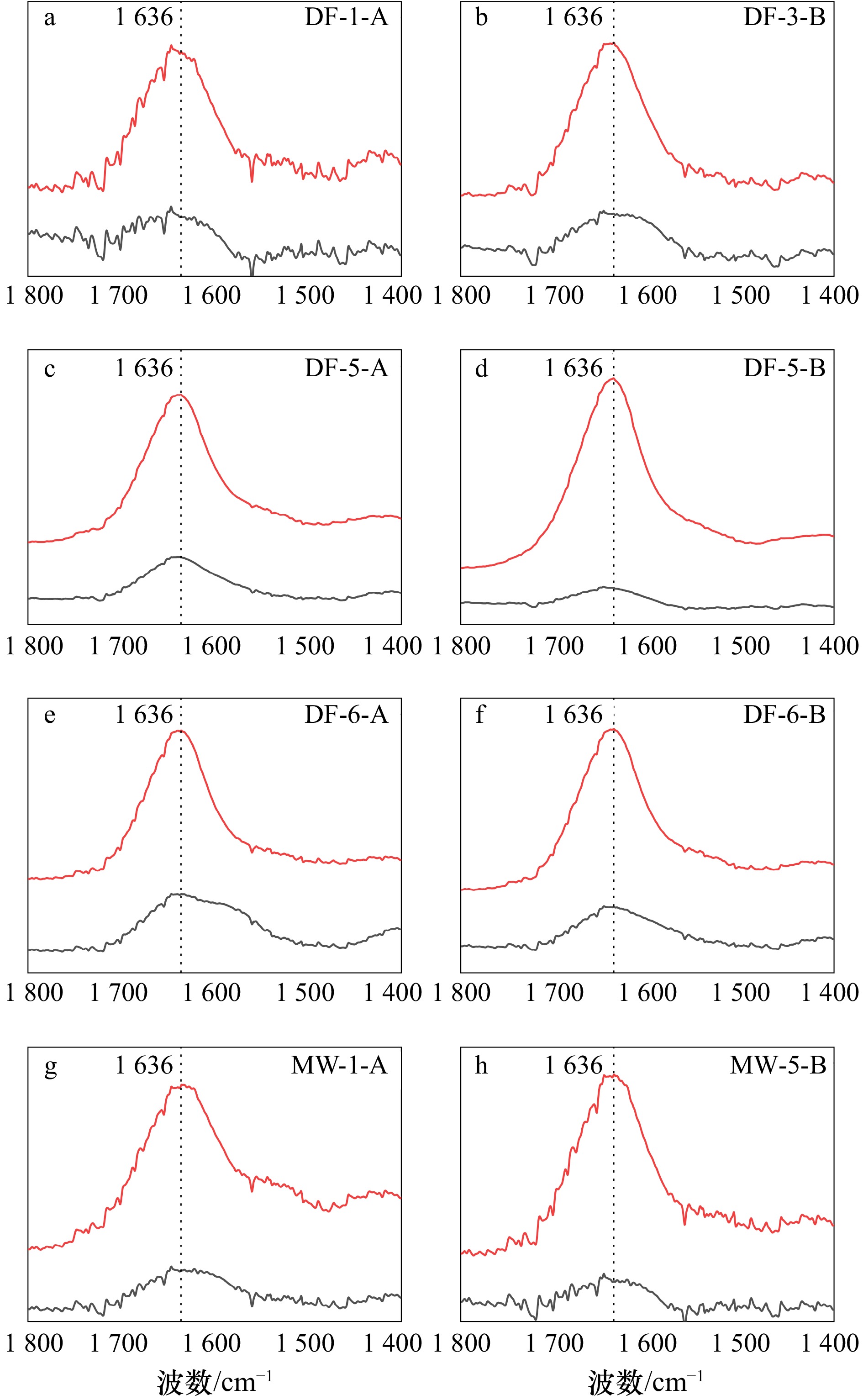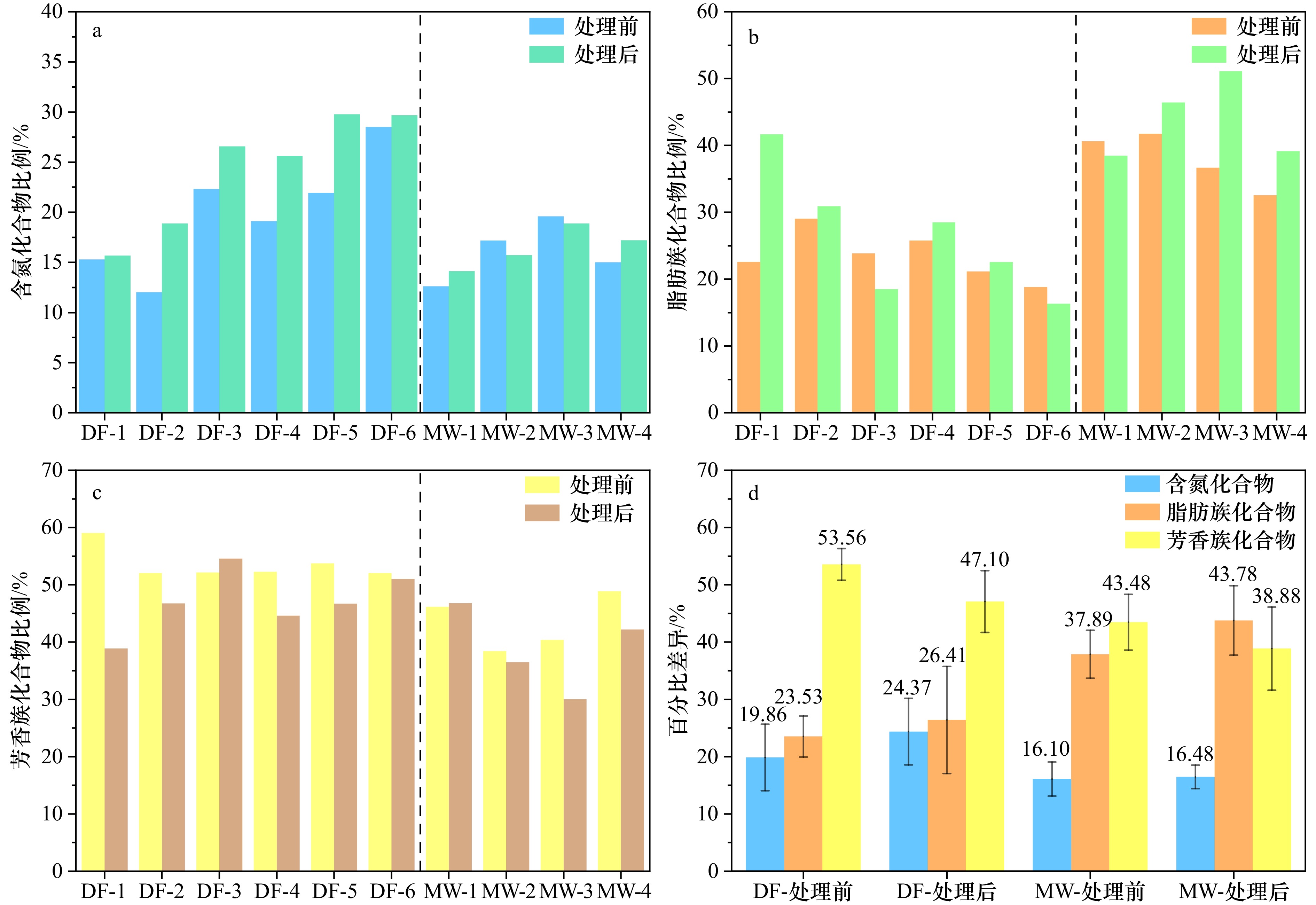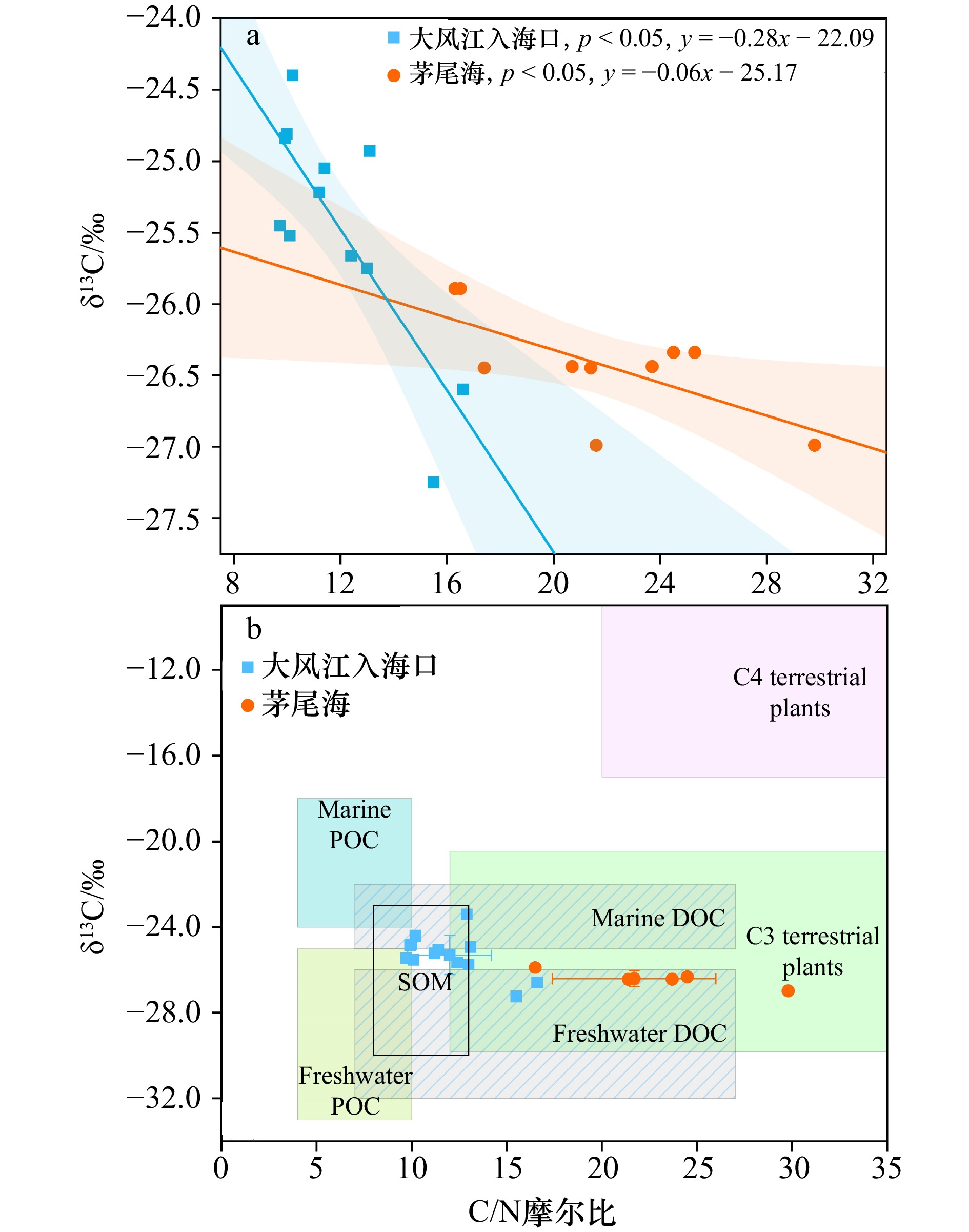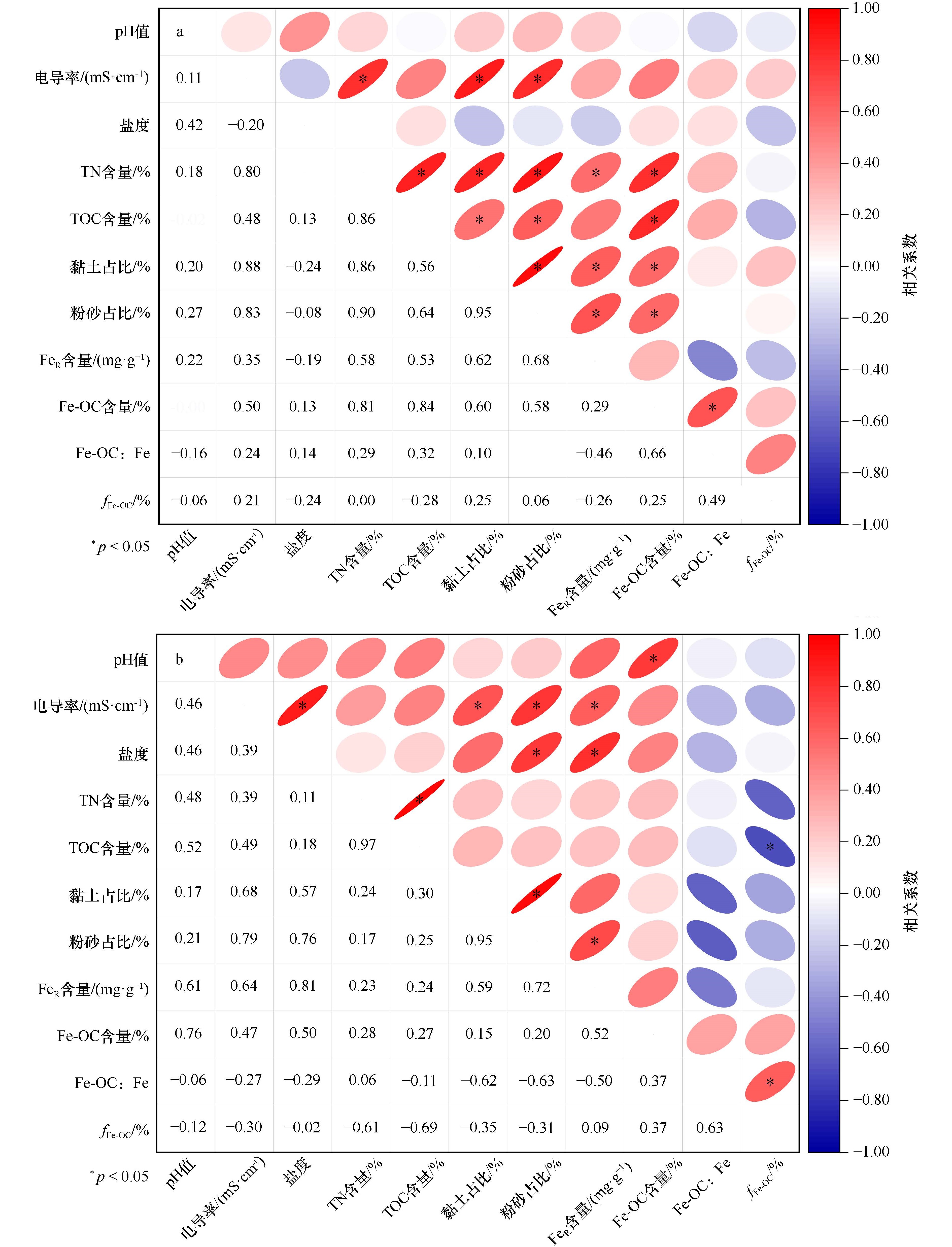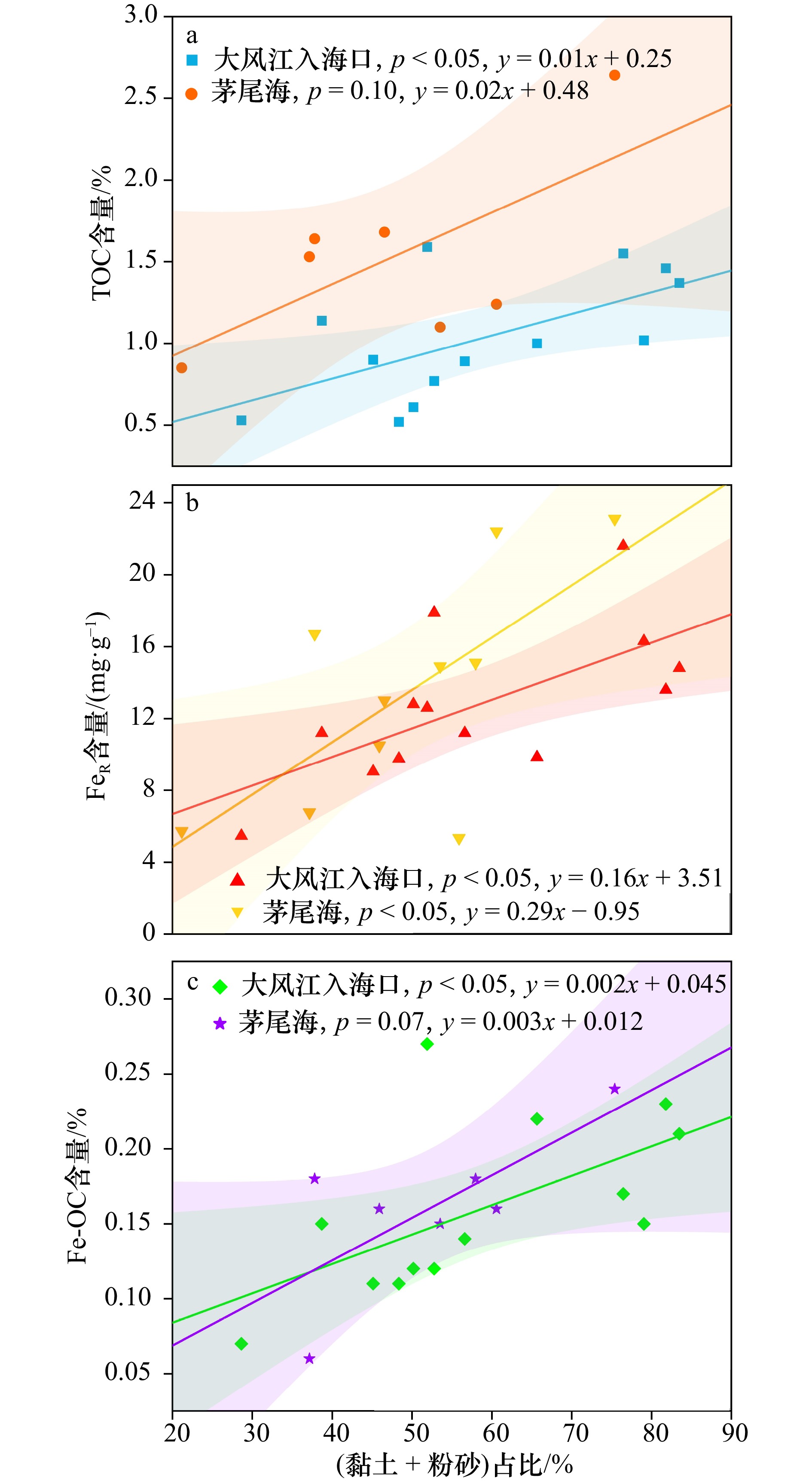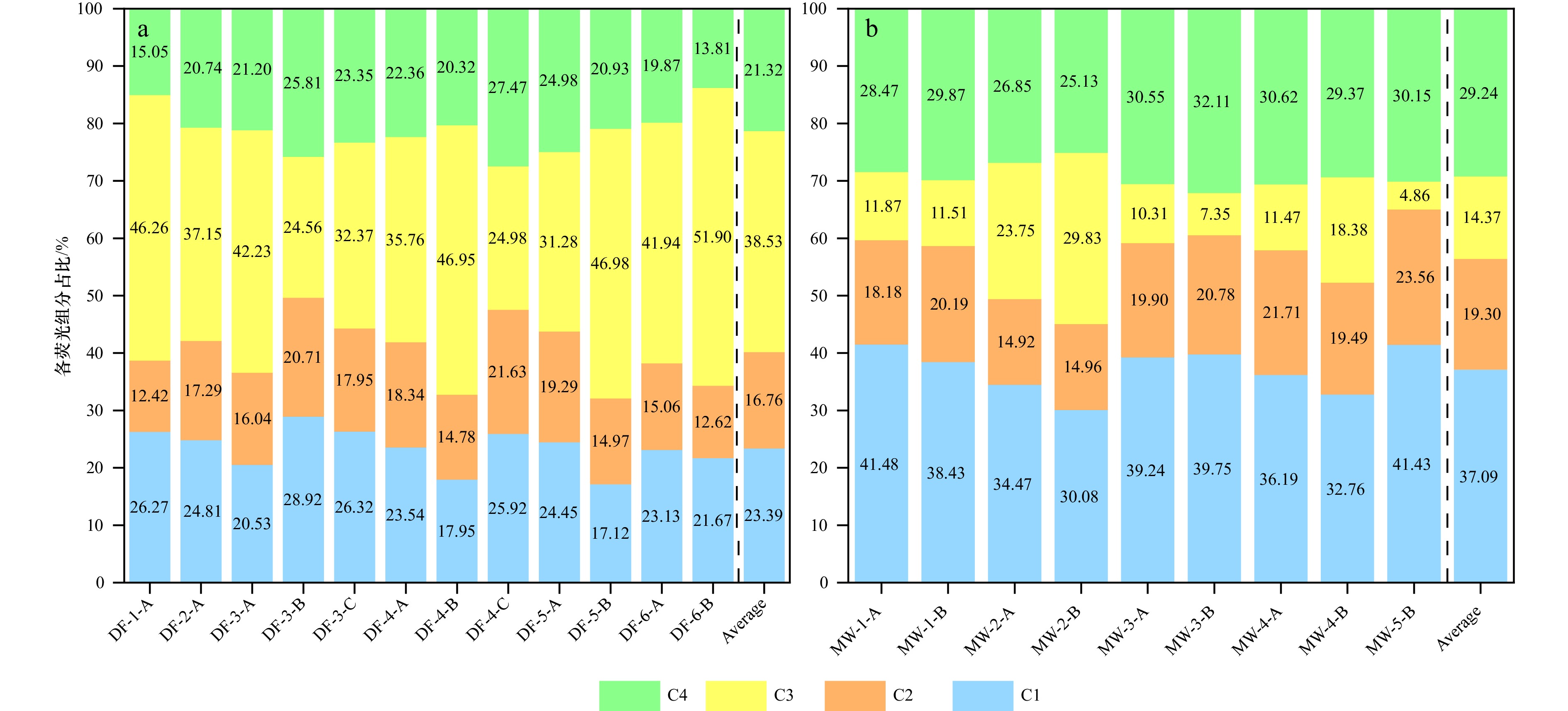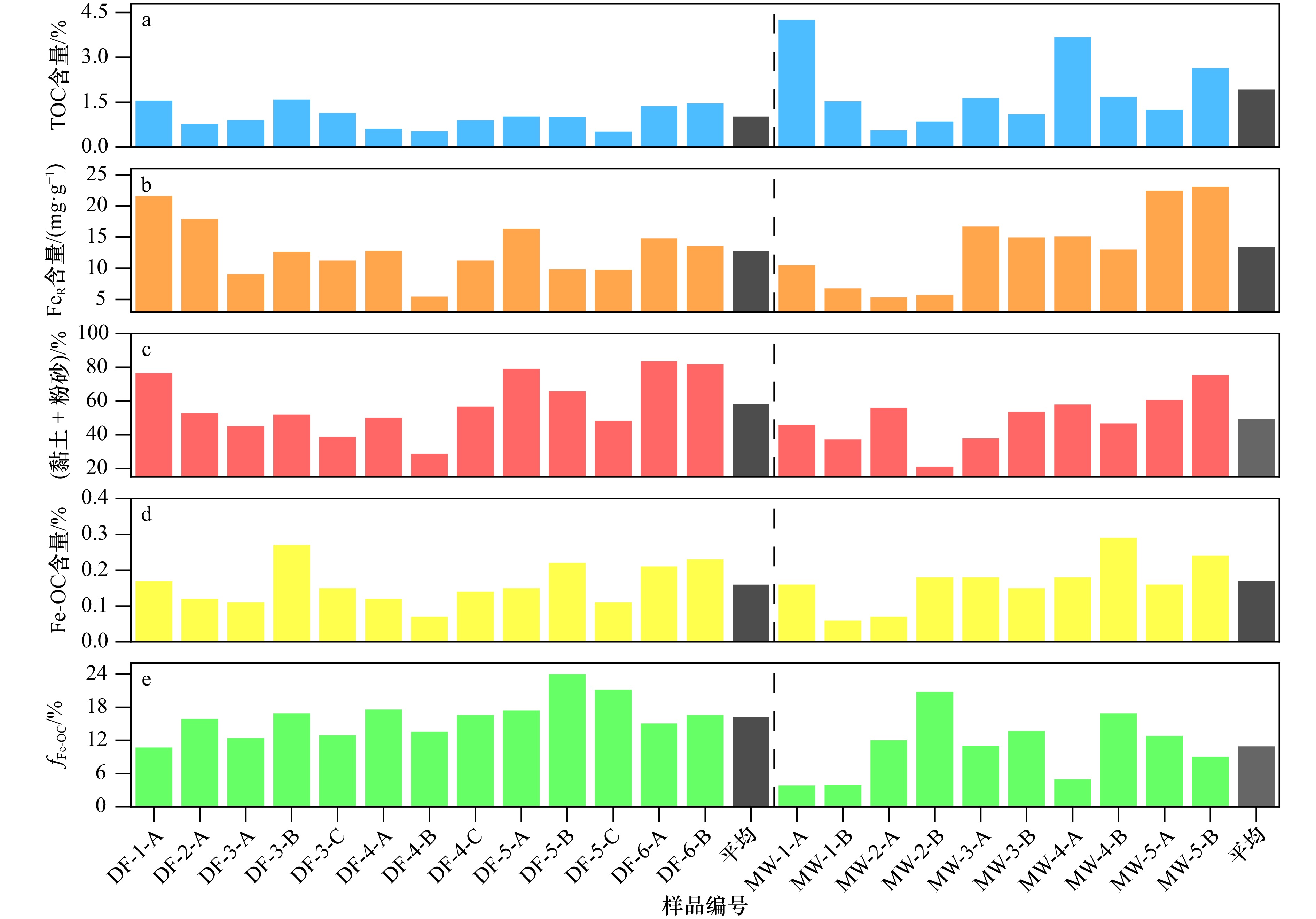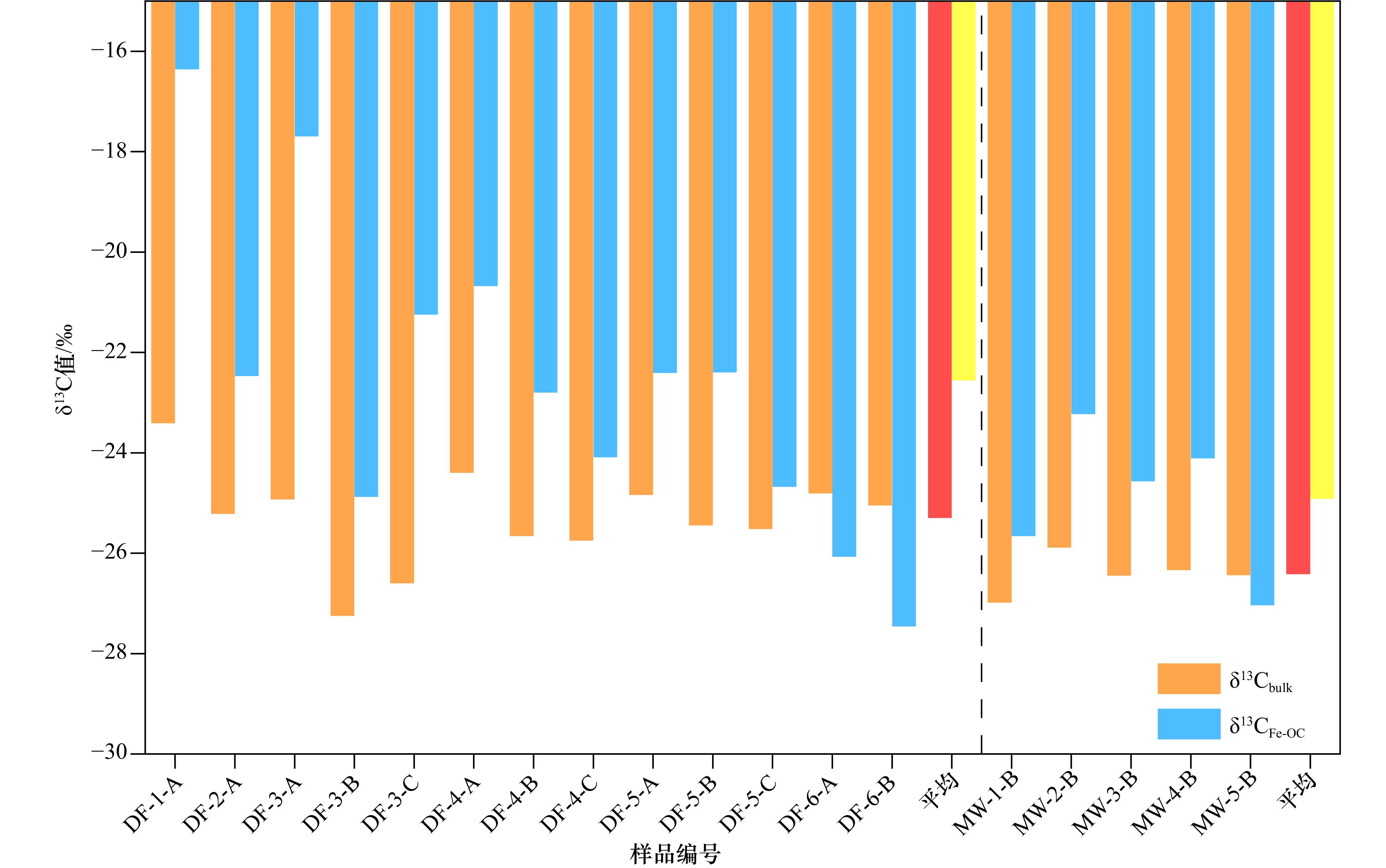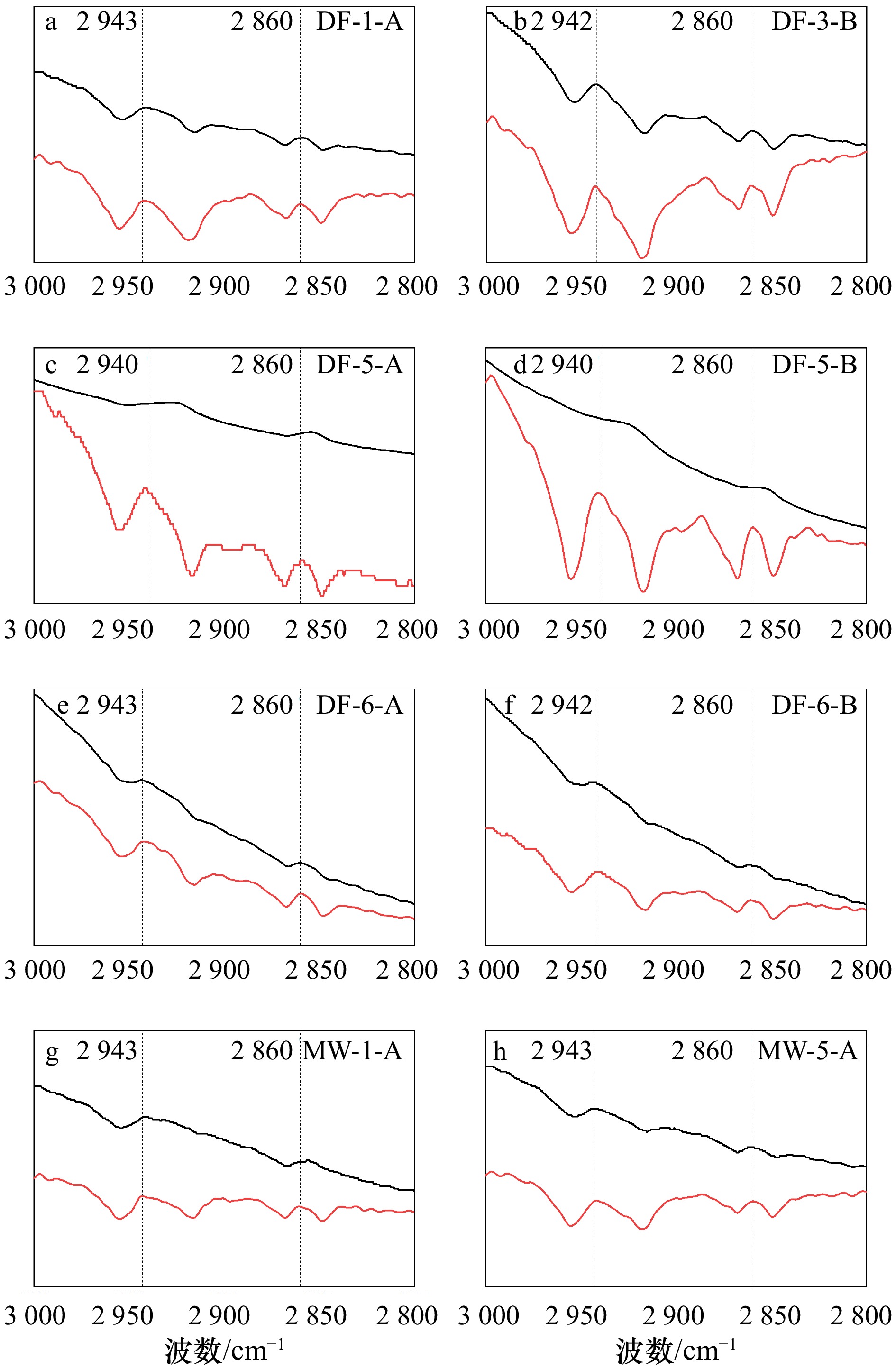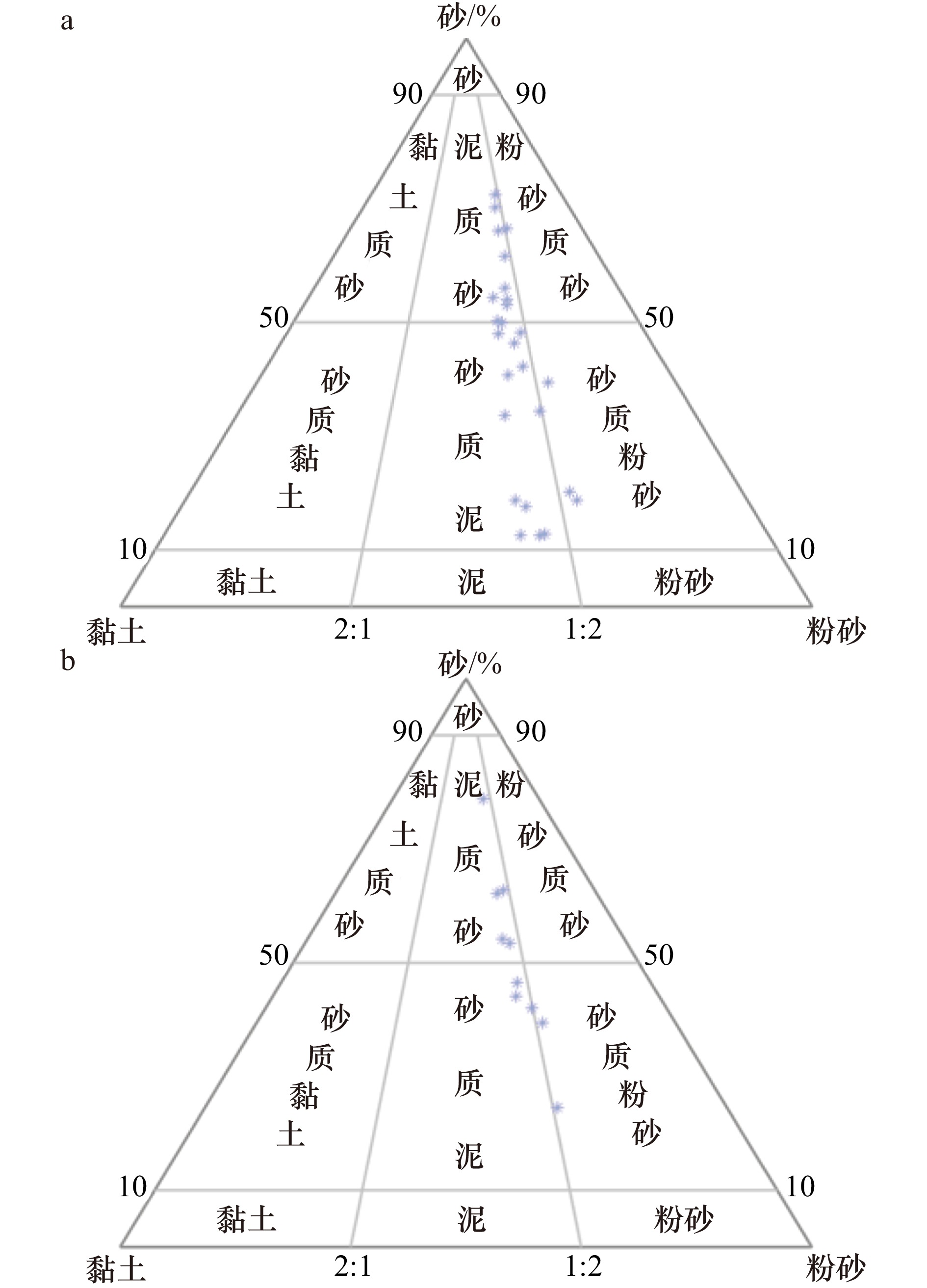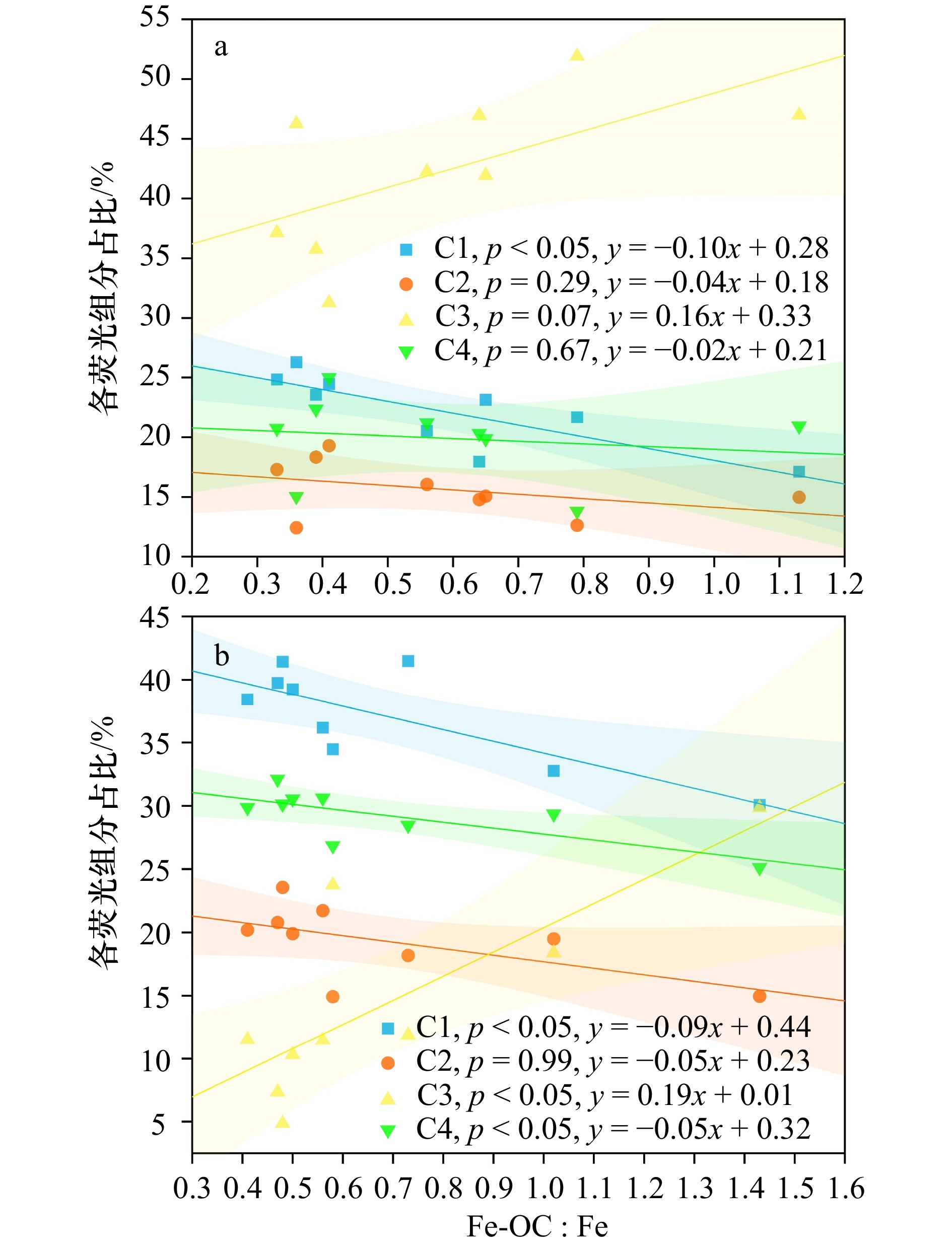The preservation of organic carbon by active iron oxides in surface sediments from Guangxi mangroves
-
摘要: 铁氧化物在全球土壤(沉积物)有机碳(Organic Carbon,OC)存储中具有重要作用。红树林湿地同时具有陆源与海源输入,为活性铁氧化物(FeR)对OC的保存提供了独特的生境。然而红树林表层沉积物中FeR对OC保存过程中的影响因素以及FeR对OC组分的选择性尚不明确。本研究选择广西大风江入海口和茅尾海周围受到潮汐与河流影响的天然红树林生境中的表层沉积物,研究沉积物中铁结合有机碳(Fe-OC)含量以及组分的变化。结果表明,大风江入海口与茅尾海表层沉积物中Fe-OC平均含量分别为0.16% ± 0.07%与0.17% ± 0.07%,在总有机碳(TOC)中所占比例(fFe-OC)分别为16.2% ± 5.04%与10.9% ± 5.63%,主要保存方式为吸附。FeR对OC的保存受到沉积物粒度、FeR含量与形态以及TOC来源与组分的影响。TOC、FeR与Fe-OC主要分布在粒度较小的沉积物组分中。表层沉积物中铁的存在形式以Fe3+为主,占总铁的87.42%,在高盐度沉积物中相对更高。FeR会选择性保存结合δ13C值(稳定性碳同位素自然丰度)偏正的OC与芳香族OC。与茅尾海相比较,大风江入海口表层沉积物Fe-OC中类蛋白荧光组分占总荧光组分的比例更高。类蛋白荧光组分占比随Fe-OC∶Fe摩尔比升高而升高。本研究有助于明确广西红树林表层沉积物中FeR对OC的选择性保存机制,加深对陆海界面沉积物中OC的保存过程的了解。Abstract: Iron oxides play a significant role in the global soil (sediment) organic carbon (OC) storage. Mangrove wetlands, receiving both terrestrial and marine inputs, provide a unique habitat for the preservation of organic carbon by reactive iron oxides (FeR). However, the impact of FeR in the surface sediments of mangroves on the preservation process of OC, as well as the selectivity of FeR towards different OC components, is still unclear. The surface sediments in the present work was collected in the natural mangrove areas around the estuaries of the Dafeng River and Maowei Sea in Guangxi, which are highly influenced by tides and rivers. The research was focused on the changes in the content and composition of iron-bound organic carbon (Fe-OC) in sediments. The results indicated that the average content of Fe-OC in surface sediments in the estuaries of Dafeng River and Maowei Sea was 0.16% ± 0.07% and 0.17% ± 0.07%, respectively. These values represented 16.2 ± 5.04% and 10.9 ± 5.63% of the total organic carbon (TOC) content in the respective sediments, which were primarily preserved through adsorption. Furthermore, the preservation of OC by FeR was influenced by the sediment particle size, the content and form of FeR, and the source and composition of TOC. TOC, FeR and Fe-OC were mainly distributed in the smaller grain size sediment fractions. The predominant form of iron in surface sediments was Fe3+, accounting for 87.42% of the total iron, and was relatively higher in high salinity sediments. FeR selectively preserved OC with higher δ13C (stable carbon isotope natural abundance) and aromatic OC. Compared with the Maowei Sea, the proportion of protein-like fluorescent components in Fe-OC of surface sediments from the Dafeng River estuary was higher and the proportion of protein-like fluorescent components increased as the molar ratio of Fe-OC∶Fe increased. This study helps to clarify the selective preservation mechanism of OC by FeR in mangrove surface sediments in Guangxi, and deepen our understanding of the preservation process of OC in land-sea interface sediments.
-
Key words:
- mangroves /
- sediments /
- iron-bound organic carbon /
- stable carbon isotope
-
1. 引言
土壤有机碳(Organic Carbon,OC)在地表碳的生物地球化学循环过程中具有重要作用。潮间带生态系统具有巨大储量的“蓝碳”,其中红树林等生态系统单位面积碳储量远高于陆地森林生态系统[1],固碳能力大约是热带森林的50倍[2]。红树林处于陆海交汇带,常年受潮汐与河流径流影响,生态环境复杂、物源丰富[3]。同时红树林属于有机碳封存量最高的湿地类型,大约有49%~98%的碳储存在其沉积物中,占全球海洋储量的14%[4]。全球OC循环中,红树林在调节气候与平衡二氧化碳方面发挥重要作用,是富碳生态系统之一[5–6],然而其沉积物中OC的具体保存机制尚不明确,有待进一步研究[5]。
沉积物中的活性铁氧化物(FeR,即能够被连二亚硫酸钠还原溶解的铁氧化物)与OC的固存与稳定性紧密相关[7]。同时,铁结合有机碳(Fe-OC)所形成的强化学键与物理保护可以改变土壤结构条件并隔绝具有分解能力的生物,进而限制OC的降解[8],有效维持沉积物中OC的长期稳定性[7]。全球海洋沉积物中大约有21.5% ± 8.6%的OC与FeR结合形成复合物[7]。红树林生境沉积物中FeR对OC保护存在两种机制:吸附与共沉淀[9]。在菲律宾多地红树林柱样沉积物的研究结果表明[4],在碎屑堆积率较高的表层沉积物中,FeR对OC的保护方式以吸附机制为主,在较深的沉积层则以共沉淀机制为主。对于红树林沉积物中的OC而言,无论是通过吸附还是共沉淀,FeR的保存作用都不容忽视。最近FeR对OC中不同碳组分的选择性保存研究表明,FeR在吸附过程中更倾向于结合芳香族OC[10],而共沉淀过程则缺乏对OC组分的选择性[11]。在沉积物吸附与共沉淀保存过程中OC也会产生分馏效应,Fe-OC在不同环境中的13C(稳定性碳同位素)相较于总有机碳(TOC)或富集或贫化[7, 12–13]。目前红树林环境中FeR对OC的选择性保存研究,特别是保存过程中的影响因素仍不明确[10]。
本研究选取我国广西壮族自治区钦州市钦南区的大风江入海口和茅尾海周围天然红树林表层沉积物作为研究对象,由于所处位置为陆海分界处的河口海湾,沉积物中OC会受到陆源与海源物质输送影响。本研究目标主要包括:(1)量化广西红树林表层沉积物中Fe-OC的含量并分析其分布特征,明确FeR含量、TOC含量、黏土与粉砂比例等因素对保存过程的影响;(2)利用沉积物中OC的δ13C值与C/N摩尔比差异,评估FeR对不同来源OC的选择性保存;(3)利用多种手段对OC结构基团进行表征,评估FeR对OC中不同组分的选择性保存。研究结果期望有助于理解不同因素对红树林表层沉积物中FeR对OC选择性保存机制及其影响因素。
2. 研究区域与研究方法
2.1 研究区域与样品采集
本研究地点位于中国广西壮族自治区钦州市南部,属于亚热带季风气候:采样站位具有不同的盐度特征,茅尾海站位为MW-1至MW-5(图1b),大风江入海口站位为DF-1至DF-6(图1c)。样品编号后字母(A、B、C)代表同一采样站位相近的表层沉积物样品(表A1与A2)。大风江注入北部湾,具有沙质河床,两岸较为稳定,延生段滩涂较长;茅尾海位于钦州市钦南区,属于半封闭内海,滩涂较短。研究区域为受潮汐影响且被红树林植被覆盖的滩涂,红树林树种为单一的秋茄(Kandelia Obovate)[14]。相比于陆地土壤系统,红树林表层沉积物会受到海水的影响,处于氧化还原条件不断变化的区域,FeR与OC之间的关联在这一环境中有可能被削弱[15]。在2022年9月13−15日,在退潮期采集0~10 cm的红树林表层沉积物,放入密封塑封袋中保存,使用便携式冰箱在0℃条件下2 h内带回实验室,用于化学分析的沉积物储存在4℃冰箱中。现场通过手持式盐度计(希玛 AR8012)测量上覆水或孔隙水的盐度与水温。
2.2 沉积物理化性质测定
沉积物样品经风干处理、研磨后过2 mm筛。使用中国国家环境保护标准电极法(HJ 802−2016)测定沉积物电导率与pH值,混合水土比为5∶1。在振荡器中于(20 ± 1)℃下振荡30 min并静置30 min,使用定性滤纸对上清液进行过滤,收集滤液进行电导率与pH值测量(FLXA402,YOKOGAWA),电导率与pH值测量精度分别为± 0.5%与± 0.01 pH。沉积物经氧化、酸化及分散预处理后使用激光粒度仪(LS13320,Coulter)测定其粒径[12]。本文根据福克(Folk)沉积物分类方法,粒径在0~
0.0625 mm的沉积物为黏土,0.0625 ~0.039 mm的为粉砂,0.039~2 mm的为砂。冷冻干燥后的样品使用1M的HCl溶液去除无机碳并洗涤,使用元素分析仪(Vario Macro CNS)进行总碳氮含量测定[13],精度为± 0.1%。δ13C值的测定则通过稳定同位素质谱仪(Delta Plus XP)进行,并以VPDB为标准,测定精度为±0.2‰。本实验采用连二亚硫酸钠−柠檬酸钠−碳酸氢钠(DCB)还原法测定沉积物中与FeR结合的OC含量[7],此提取过程将释放FeR及Fe-OC,收集上清液与后续洗涤溶液并加少量盐酸合并,保存在4℃冰箱中备测。使用相同离子强度的氯化钠代替柠檬酸钠与连二亚硫酸钠作为空白对照组。样品Fe-OC含量即为空白对照组与实验组DCB处理后剩余固体样品中OC含量之差。使用邻菲罗啉比色法进行DCB法还原过程中所释放的FeR含量测定,通过吸光度进行FeR含量计算,使用仪器为分光光度计(UV-2600),测量精度为± 0.3%。在DCB还原法处理后,Fe-OC在样品中被选择性去除,将剩余样品中13C记作δ13Cnon-Fe-OC,计算后得到去除的Fe-OC中13C记作δ13CFe-OC,原始样品中13C记作δ13Cbulk[16]。
2.3 铁氧化物的分析方法
穆斯堡尔谱(Mӧssbauer spectrum)测试[17]可以获得沉积物中铁的化学形态。进行57Fe穆斯堡尔谱测试之前,将所测试的沉积物样品研磨成100目的粉末并装入黄铜胶囊(半径16 mm,厚1 mm)。穆斯堡尔谱使用1.11 GBq 57Co/Rh的γ射线源在室温(293 K)下采集。同质异能移根据光谱中心的位移来表示的。使用标准线形拟合程序将穆斯堡尔谱拟合为洛伦兹线形,随后调整四重峰的强度和半宽度[18]。
2.4 有机碳的分析方法
2.4.1 红外光谱分析
选择8个TOC含量较高的红树林表层沉积物,使用傅立叶变换红外光谱仪(Nicolet iS50)测量了DCB处理前后的全反射−傅立叶变换红外光谱(ATR-FTIR)[13],以表征TOC及Fe-OC中OC组分的分子信息。测量参数设置:波数范围为
4000 ~525 cm−1;扫描次数为64次;空气背景。使用OMNIC(版本 8.0)软件收集数据、校正基线和转换光谱。使用Origin 2018软件绘制红外光谱。2.4.2 热裂解−气相色谱/质谱法分析
选择10个TOC含量较高的红树林表层沉积物进行原始样品与提取Fe-OC后的样品测定。使用微型炉热解器(EGA/PY-3030D,Frontier)进行热裂解−气相色谱/质谱法(PY-GC/MS)[19]测试。将约1 mg样品装入热解器的样品架中,并在500℃的温度下进行热解,加热速率为20℃/ms,热解时间为0.2 min。使用DB-5MS毛细管柱(30 m × 0.25 mm × 0.25 μm)进行GC/MS(5975c,Agilent)测试。喷射器温度保持在300℃,使用1∶30的分流比。烘箱温度设定为从40℃开始持续2 min,然后以5℃/min加热到100℃,并保持2 min。以同样的升温速率加热到280℃,并保持5 min。根据美国国家标准与技术研究院(NIST)数据库和之前的文献鉴定热解产物[20],为便于后续分析,将OM归纳为3个结构组分:含氮化合物(N-化合物,主要为吡咯、吡啶、酰胺类化合物、吲哚、氰化物为主)、脂肪族(烷烃、烯烃、脂肪酸、碳水化合物为主)与芳香族(苯同系物、多环芳烃、苯酚为主),这些结构基团的相对比例用总峰面积的百分比表示[19]。
2.4.3 三维荧光光谱测量及组分分析
将实验组与空白对照组提取的所有上清液稀释50倍后用荧光分光光度计(Hitachi F-4700)测量三维荧光光谱[21],以观察Fe-OC荧光组分的改变。取一定量的上清液于石英比色皿中,激发波长设为220~450 nm,间隔5 nm;发射波长设为230~600 nm,间隔2 nm。激发和发射带宽均设置为5 nm,扫描速度
12000 nm/min。在370 nm的吸光度大于0.02或者254 nm的吸光度大于0.3的上清液样品需要进一步稀释,以消除再吸收和内滤效应[22]。测定时以Milli-Q水为空白校准拉曼效应。测量的荧光强度通过除以Milli-Q水在激发波长为350 nm,发射波长为380~420 nm下的峰面积进行归一化[23]。使用Matlab R2021a中的DOMFluor工具包[24]进行平行因子分析,在OpenFluor数据库中匹配建模组分[25]。将提取溶液(等浓度的连二亚硫酸钠、碳酸氢钠溶液)进行检测,谱图中并未出现任何有效峰。空白对照组中,使用NaCl处理后的样品上清液稀释后进行检测,仅发现少量类蛋白C3荧光组分,可视为实验组背景值。2.5 数据统计与主成分分析
本研究采用SPSS 25软件进行分析。测量各参数之间的相关性通过皮尔逊相关系数分析和双尾检验确定,显著性差异通过t检验确定。
3. 结果
3.1 水文与沉积物特征
大风江与茅尾海表层沉积物的粒径分布见图2c,完整的相关参数包括盐度、pH等见表A1与表A2。大风江入海口沿岸的红树林受海水以及河流径流影响,盐度分布不均,从最低值3.08至最高值23.40,随着盐度上升,沉积物pH值由5.73上升至8.18。沉积物主要以粉砂与砂为主,黏土在所有组分中所占比例最低。黏土占比从10.11%至28.64%,平均值为21.39% ± 7.49%;粉砂占比从18.52%至54.85%,平均值为36.26% ± 12.06%。茅尾海样品处于湾内,其盐度从最低值3.01‰至最高值20.60‰,沉积物pH值由2.88上升至6.31。沉积物同样以粉砂与砂为主,黏土占比从8.11%至24.55%,平均值为17.36% ± 4.56%;粉砂占比从13.05%至50.85%,平均值为31.83% ± 10.63%。相较于大风江入海口的pH值(6.67 ± 0.85),茅尾海红树林样品的pH值(4.84 ± 0.94)较低(p < 0.05)。两地沉积物中黏土+粉砂平均占比之和为54.37% ± 16.77%。
3.2 TOC、FeR、Fe-OC、δ13C值与C/N摩尔比变化
大风江与茅尾海表层沉积物的TOC、FeR、Fe-OC、fFe-OC分布情况见图2,δ13Cbulk值与δ13CFe-OC值分布情况见图3,完整的相关参数见表A3与表A4。
大风江入海口表层沉积物中TOC含量从0.52%至1.59%,平均值为1.02% ± 0.46%;δ13Cbulk值变化范围从−27.25‰至−23.41‰,平均值为−25.30‰ ± 0.93‰,近海区域相较内陆部分偏正。茅尾海沉积物的TOC含量从0.56%至4.26%,平均值为1.92% ± 1.23%,比大风江平均值高出约90.2%。δ13Cbulk值变化范围从−26.99‰至−25.89‰,平均值为−26.42‰ ± 0.37‰,相较于大风江入海口偏负(p < 0.05),差值约为−1.13‰。在C/N摩尔比的分布方面,大风江入海口沉积物从9.72至16.6,平均值为12.0 ± 2.20。茅尾海则从16.3至29.8,平均值为21.7 ± 4.30,高于大风江入海口。
大风江入海口表层沉积物中,FeR含量从5.47 mg/g至21.6 mg/g,平均值为(12.8 ± 4.19) mg/g;Fe-OC含量变化范围从0.07%至0.27%,平均值为0.16% ± 0.07%;fFe-OC变化范围从10.7%至24.0%,平均值为16.2% ± 3.58%;δ13CFe-OC值范围从−27.46‰至−16.36‰,平均值为−22.56‰ ± 3.05‰;Fe-OC∶Fe摩尔比平均值为0.61 ± 0.27。茅尾海表层沉积物中,FeR含量范围从5.35 mg/g至23.1 mg/g,平均值为(13.4 ± 6.39) mg/g;Fe-OC含量变化范围从0.07%至0.29%,平均值为0.17% ± 0.07%;fFe-OC变化范围从3.87%至20.8%,平均值为10.9% ± 5.62%;δ13CFe-OC值范围从−27.04‰至−23.23‰,平均值为−24.93‰ ± 1.39‰;Fe-OC∶Fe摩尔比平均值为0.65 ± 0.33。大风江入海口表层沉积物中盐度与FeR、Fe-OC含量相关性较弱,而在茅尾海中盐度与FeR之间正相关性较强(p < 0.05),与Fe-OC含量也存在一定的正相关性。
3.3 沉积物中铁氧化物与Fe-OC的表征
3.3.1 穆斯堡尔谱对铁氧化物价态与物相分析
通过穆斯堡尔谱测量可以判断红树林沉积物中Fe2+与Fe3+的比例,分析存在盐度差异的区域中铁组分的分布与变化情况。同质异能移(IS)和四极分裂(QS)差异较大的3个样品(DF-1-A、DF-6-A、MW-3-A)的穆斯堡尔谱图见图4,其他相关谱图与穆斯堡尔谱参数见图A1与表A5。所有样品中除MW-3-A只有一个双峰外,其他表层沉积物均有两个双峰(图A1)。较高的同质异能移和四极分裂双峰(D1)被归为八面体配位的顺磁性高自旋Fe2+双峰(para-Fe2+),较低的同质异能移和四极分裂双峰(D2)被归为低自旋Fe3+双峰(para-Fe3+)[26]。通过同质异能移、四极分裂、吸收峰面积等参数计算得出DF-1-A中Fe2+/Fe3+ = 0.193,高于DF-6-A(0.148)。MW-3-A样品未能检出D1峰,表明样品中没有Fe2+存在。
 图 4 广西大风江入海口(DF)与茅尾海(MW)红树林典型表层沉积物的穆斯堡尔谱图a. DF-1-A站位,b. DF-6-A站位,c. MW-3-A站位。D1:顺磁性高自旋亚铁的双峰(para-Fe2+);D2:低自旋三价铁的双峰(para-Fe3+)Figure 4. Mössbauer spectra of typical surface sediments in the estuary of Dafeng River (DF) and Maowei Sea (MW) from Guangxi mangrovesa. DF-1-A site, b. DF-6-A site, c. MW-3-A site. D1: doublet for paramagnetic high-spin ferrous iron (para-Fe2+); D2: doublet for low-spin ferric iron (para-Fe3+)
图 4 广西大风江入海口(DF)与茅尾海(MW)红树林典型表层沉积物的穆斯堡尔谱图a. DF-1-A站位,b. DF-6-A站位,c. MW-3-A站位。D1:顺磁性高自旋亚铁的双峰(para-Fe2+);D2:低自旋三价铁的双峰(para-Fe3+)Figure 4. Mössbauer spectra of typical surface sediments in the estuary of Dafeng River (DF) and Maowei Sea (MW) from Guangxi mangrovesa. DF-1-A site, b. DF-6-A site, c. MW-3-A site. D1: doublet for paramagnetic high-spin ferrous iron (para-Fe2+); D2: doublet for low-spin ferric iron (para-Fe3+)Fe2+的同质异能移和四级分裂值表示其主要以黏土矿物或其他硅酸盐相为主,如绿泥石(IS = 1.09~1.14 mm/s, QS = 2.59~2.66 mm/s)或伊利石(IS = 1.12 mm/s, QS = 2.61 mm/s)[26-27]。大多数采样点的Fe3+相主要以水铁矿(IS = 0.35~0.36 mm/s, QS = 0.52~0.90 mm/s)、纤铁矿或四方纤铁矿(IS = 0.37 mm/s, QS = 0.53 mm/s;IS = 0.37~0.38 mm/s, QS = 0.55~0.95 mm/s)的形态存在。拟合后的结果显示(表A5),大风江入海口表层沉积物中Fe2+/Fe3+比值(0.17 ± 0.04)高于茅尾海(0.07 ± 0.05)。两地表层沉积物中Fe3+在总铁中所占比例平均为87.42%,Fe3+占比与FeR含量不存在明显相关性(p > 0.05)。
3.3.2 全反射−傅里叶变换红外光谱分析有机碳结构
用ATR-FTIR对DCB提取前后的8个样品(DF-1-A、DF-3-B、DF-5-A、DF-5-B、DF-6-A、DF-6-B、MW-1-A、MW-5-A)进行Fe-OC与non-Fe-OC化学成分的差异表征(图5、图6与图A2)。波数为
1750 ~1600 cm−1与3000 ~2800 cm−1范围内的红外光谱可用于OC的表征[28],在1750 ~1600 cm−1范围主要包含酰胺、羧酸酯和芳香化合物官能团指纹峰,在3000 ~2800 cm−1范围则主要是脂肪族指纹峰[29]。从图5、图6可见,未经DCB处理的样品在1636 cm−1处有显著吸收峰,归属为芳香族OC的存在,经过DCB处理后,所有样品此处的峰高明显下降;与此同时,在原始样品中3000 ~2800 cm−1范围内的2940 cm−1与2860 cm−1左右无明显的吸收峰存在,经过DCB处理后则清晰地显示出来,说明脂肪族OC的存在[20]。DCB处理前后的光谱结果表明,芳香族OC在提取过程中被选择性清除,使得脂肪族OC反应后在剩余样品中存在更为明显[21]。 图 5 广西大风江入海口(DF)与茅尾海(MW)红树林表层沉积物在DCB处理前后
图 5 广西大风江入海口(DF)与茅尾海(MW)红树林表层沉积物在DCB处理前后1800 ~1400 cm−1范围内衰减全反射−傅里叶变换红外光谱差异(ATR-FTIR)红线为原始样品,黑线为DCB处理后样品。所有光谱均经过背景校准Figure 5. Variations in attenuated total reflectance-Fouriertransform infrared (ATR-FTIR) spectra in the1800 −1400 cm−1 range for surface sediments in the estuary of Dafeng River (DF) and Maowei Sea (MW) from Guangxi mangroves before and after DCB treatmentThe red line represents the original sample, while the black line represents the sample after DCB treatment. All spectra are background-corrected 图 6 广西大风江入海口(DF)与茅尾海(MW)红树林表层沉积物在DCB处理前后
图 6 广西大风江入海口(DF)与茅尾海(MW)红树林表层沉积物在DCB处理前后3000 ~2800 cm−1范围内衰减全反射−傅里叶变换红外光谱差异(ATR-FTIR)红线为原始样品,黑线为DCB处理后样品。所有光谱均经过背景校准Figure 6. Variations in attenuated total reflectance-Fouriertransform infrared (ATR-FTIR) spectra in the3000 −2800 cm−1 range for surface sediments in the estuary of Dafeng River (DF) and Maowei Sea (MW) from Guangxi mangroves before and after DCB treatmentThe red line represents the original sample, while the black line represents the sample after DCB treatment. All spectra are background-corrected3.3.3 热裂解−气相色谱/质谱分析有机碳组成
PY-GC/MS结果显示(图7),在大风江的6个表层沉积物样品中,含氮化合物、脂肪族、芳香族在总结构基团中所占比例分别为19.86% ± 5.80%、23.53% ± 3.58%、53.56% ± 2.76%。茅尾海的4个表层沉积物样品中各自相应基团的占比分别为16.10% ± 2.98%、37.89% ± 4.19%、43.48% ± 4.87%。两地的表层沉积物中芳香族OC都属于最丰富的成分,脂肪族其次而含氮化合物最少。在受陆地影响更强的茅尾海沉积物中脂肪族OC占比更高,比大风江高出14.36%。在DCB处理后,大风江表层沉积物中含氮化合物、脂肪族、芳香族的占比变为24.37% ± 5.82%、26.41% ± 9.34%、47.10% ± 5.39%,比未经DCB处理样品的芳香族占比减少6.46%。茅尾海表层沉积物在DCB处理后含氮化合物、脂肪族、芳香族的占比为16.48% ± 2.04%、43.78% ± 6.07%、38.88% ± 7.25%,芳香族占比减少了4.60%。原始样品的芳香族OC中苯酚衍生物占比为34.17% ± 5.82%,DCB处理后占比为35.52% ± 7.41%,并无显著差异(p > 0.05)。
 图 7 广西大风江入海口(DF)与茅尾海(MW)红树林表层沉积物原始样品与DCB处理后含氮化合物(a)、脂肪族(b)、芳香族(c)在总结构基团中相对比例与平均值百分比差异(d)Figure 7. Relative proportions of nitrogenous compounds (a), aliphatics (b), aromatics (c) in the total structural groups, and the average percentage difference (d) in surface sediment original samples and after DCB treatment in the estuary of Dafeng River (DF) and Maowei Sea (MW) from Guangxi mangroves
图 7 广西大风江入海口(DF)与茅尾海(MW)红树林表层沉积物原始样品与DCB处理后含氮化合物(a)、脂肪族(b)、芳香族(c)在总结构基团中相对比例与平均值百分比差异(d)Figure 7. Relative proportions of nitrogenous compounds (a), aliphatics (b), aromatics (c) in the total structural groups, and the average percentage difference (d) in surface sediment original samples and after DCB treatment in the estuary of Dafeng River (DF) and Maowei Sea (MW) from Guangxi mangroves3.3.4 三维荧光分析有机碳荧光组分
将DCB提取后含Fe-OC的上清液稀释并检测,得到以下4种主要组分(表1):C1、C2、C4被认为是3种陆源类腐殖质荧光组分,C3被认为是一种海源类蛋白荧光组分。其中C1被认为是一种陆源微生物类腐殖质荧光组分[30],C2被认为是陆源农业水区和淡水环境的类腐殖质荧光组分[31-32]。C3类似于海源色氨酸或者蛋白质荧光组分[33],可能来自湿地中自生物质或微生物加工。C4同样被认为是一种陆源类腐殖酸荧光组分[34]。
表 1 广西大风江入海口与茅尾海红树林表层沉积物中Fe-OC荧光组分的鉴定Table 1. Identification of fluorescent components of Fe-OC in surface sediments in the estuary of Dafeng River and Maowei Sea from Guangxi mangroves大风江入海口荧光组分(C1−C4)在总荧光组分中所占比例分别为22.49% ± 4.68%、16.24% ± 3.39%、40.45% ± 11.03%、20.81% ± 4.25%。茅尾海占比分别为37.09% ± 3.99%、19.30% ± 2.89%、14.37% ± 8.08%、29.24% ± 2.13%,两地各荧光组分占比差异较大(p < 0.05)(图A3)。
4. 讨论
4.1 TOC、FeR、粒度对Fe-OC含量的影响
大风江入海口(1.02% ± 0.46%)与茅尾海(1.92% ± 1.23%)红树林表层沉积物中的TOC含量高于黄河口(0.62% ± 0.20%)[35]、南黄海边缘(0.75% ± 0.35%)[36]与长江口(0.34% ± 0.19%)[12]的表层沉积物。相较于其他类型滨海湿地,红树林地区因低氧条件和发达的根系而对OC有更强的固存能力[9],但表层沉积物受到水流频繁的物理加工,TOC被部分分解[10]。
FeR大部分表现为Fe3+的矿物形式,其含量往往与Fe3+的占比存在明显正相关关系[10, 12],由Fe3+的占比及铁氧化物的含量共同决定。Fe3+存在于水铁矿、赤铁矿、纤铁矿中,这些铁的(氢)氧化物具有高比表面积、高孔隙率以及良好的吸附性[37]。本研究中,Fe3+在总铁中所占比例平均高达87.42%,在茅尾海的MW-3-A样品中占比高达100.00%,远高于我国长江口滨海湿地铁氧化物中Fe3+的占比(40%~60%)[12]。高Fe3+与低Fe2+占比可能对本研究中FeR与OC的结合存在一定影响,共沉淀形成的复合物分布情况往往取决于Fe2+浓度[38],Sodano等[39]描述了Fe2+氧化与水解伴随的共沉淀过程并证明含水土壤中Fe2+对于共沉淀过程的重要性。红树林表层沉积物中Fe2+占比相对较低,发生的共沉淀过程可能较少,导致大部分沉积物样品中FeR与OC结合的主要方式为吸附。Fe2+占比在大风江入海口流域中与盐度、pH值呈负相关性,可能是由于盐度较高区域的沉积物中硫化物造成的缺氧环境影响较小而不能提供足够的还原条件。此外,我们观察到Fe2+/Fe3+比值在大风江入海口与茅尾海表层沉积物中存在差异:大风江中Fe2+/Fe3+比值平均为0.17 ± 0.04,显著高于茅尾海的0.07 ± 0.05(p < 0.05),这可能与陆源物质的输入有关。河口地区是溶解性陆源铁输入的重要汇,大量铁通过河流输送到海洋中,被有效捕获在近岸地区并与沉积物一起沉淀[40]。茅尾海相较于大风江入海口陆源OC输入更强(4.2节,图11b),在影响OC来源的同时也使河流直接输入的Fe3+在表层沉积物中具有更高的占比,进而导致茅尾海表层沉积物中的FeR含量[(13.4 ± 6.39) mg/g]略高于大风江[(12.8 ± 4.19) mg/g],更加有利于吸附过程的发生。吸附机制可以部分解释TOC与FeR含量的正相关关系[41]。
金属矿物往往与黏土−粉砂表面结合,再与有机物结合形成黏土粉砂−金属−有机物复合体[11, 40-41]。本研究中表层沉积物主要为泥砂混合物(图8),FeR、TOC、Fe-OC三者含量与黏土、粉砂所占比例具有良好的正相关关系(图9、图10),与文献结果一致[12, 36]。这种良好的正相关关系表明TOC、FeR、Fe-OC主要分布在细粒组分中,可能与水动力的分选效果以及黏土、粉砂对OC的吸附有关。茅尾海表层沉积物中FeR与Fe-OC的含量与盐度存在的一定正相关关系,归因于茅尾海的高盐度区域中粒径较小的沉积物占比相对较高(p < 0.05)。大风江入海口表层沉积物粒径分布则未与盐度表现出明显的耦合性,可能是高度动态变化的水文沉积环境以及沉积物的迁移或物理改造导致,沉积物空间分布较为复杂[35]。虽然存在较强的关联性,但细粒组分对于OC的稳定作用存在争议,不同地区中使用单一的粒度因素并不能完全解释沉积物中TOC的变化[13]。
 图 9 广西红树林表层沉积物各参数相关性a. 大风江入海口,b. 茅尾海。椭圆形部分为皮尔逊相关性表示图,红色为正相关,蓝色为负相关,星号表示相关性显著(p < 0.05);数字部分为具体的皮尔逊相关性系数大小Figure 9. Correlation analysis of various parameters in surface sediments from Guangxi mangrovesa. The estuary of Dafeng River, b. Maowei Sea. The elliptical part represents Pearson correlation representation, where red indicates positive correlation, blue indicates negative correlation, and asterisks denote significant correlations (p < 0.05); the number part represents specific Pearson correlation coefficients
图 9 广西红树林表层沉积物各参数相关性a. 大风江入海口,b. 茅尾海。椭圆形部分为皮尔逊相关性表示图,红色为正相关,蓝色为负相关,星号表示相关性显著(p < 0.05);数字部分为具体的皮尔逊相关性系数大小Figure 9. Correlation analysis of various parameters in surface sediments from Guangxi mangrovesa. The estuary of Dafeng River, b. Maowei Sea. The elliptical part represents Pearson correlation representation, where red indicates positive correlation, blue indicates negative correlation, and asterisks denote significant correlations (p < 0.05); the number part represents specific Pearson correlation coefficients 图 10 广西大风江入海口与茅尾海红树林表层沉积物中黏土、粉砂占比与TOC(a)、FeR(b)、Fe-OC(c)含量的相关关系阴影部分为95%置信带Figure 10. The correlation between the proportions of clay and silt and the contents of TOC (a), FeR (b) and Fe-OC (c) insurface sediments in the estuary of Dafeng River and Maowei Sea from Guangxi mangrovesThe shaded part is 95% confidence band
图 10 广西大风江入海口与茅尾海红树林表层沉积物中黏土、粉砂占比与TOC(a)、FeR(b)、Fe-OC(c)含量的相关关系阴影部分为95%置信带Figure 10. The correlation between the proportions of clay and silt and the contents of TOC (a), FeR (b) and Fe-OC (c) insurface sediments in the estuary of Dafeng River and Maowei Sea from Guangxi mangrovesThe shaded part is 95% confidence band大风江入海口(0.16% ± 0.07%)与茅尾海(0.17% ± 0.07%)的天然红树林表层沉积物中Fe-OC含量相近,与Dicen等[4]在苏比克(Subic)(0.11% ± 0.04%)与奥布布(Oboob)(0.12% ± 0.02%)地区的天然红树林表层沉积物中Fe-OC含量接近,但明显低于全球其他典型湿地较为稳定或深层次沉积物中的Fe-OC含量(表2)。Fe-OC∶Fe摩尔比可以用来粗略判断FeR与OC的结合方式,若小于1则表示主要结合方式为吸附,在6~10之间则为共沉淀[11]。大风江入海口表层沉积物Fe-OC∶Fe摩尔比平均为0.61 ± 0.27,茅尾海为0.65 ± 0.33,说明本研究中FeR与OC的主要结合方式为吸附,共沉淀的贡献有限。美国密西西比河腊湖三角洲(Wax Lake Delta)的新生位点(碎屑沉积率较高的区域)Fe-OC∶Fe摩尔比约为0.55(与本研究中两地的平均值接近),Shields等[11]对Fe-OC含量与Fe-OC∶Fe摩尔比较低情况的解释为:该区域受FeR保护的OC主要是水体中的矿物颗粒与OC预沉积形成的;相较于稳定区域的沉积物,新生区域中FeR与OC的结合潜力并未完全释放,吸附过程可能也是其他碎屑沉积率较高区域的主要作用机制[11]。广西红树林表层沉积物中Fe-OC含量与Fe-OC∶Fe摩尔比低于其他深层次(成熟)的红树林沉积物[4],在较高的碎屑沉积率与水动力的物理扰动影响下,FeR可能需要通过埋藏与稳定来结合更多的OC。
表 2 全球典型湿地类型铁氧化物与有机碳结合情况(改自文献[44])Table 2. The combination of iron oxides with organic carbon in global typical wetland types [44]站位 站位类型 pH值 占比/% Fe3+/(μmol·g−1) SOC/(mg·g−1) Fe-bound C/(mg·g−1) fOC-Fe/% Fe-OC∶Fe摩尔比 参考文献 全球海洋 河口/海洋沉积物 – – – – – 21.5 ± 8.6 4.0 ± 2.8 Lalonde等[7] 沃斯托克湖,美国 河流沉积物(新生) – – 47.0 ± 23.1 6.2 ± 1.1 0.7 ± 0.6 8.1 ± 3.2 0.5 ± 0.2 Shields等[11] 沃斯托克湖,美国 河流沉积物(成熟) – – 83.5 ± 15.9 31.5 ± 5.2 7.1 ± 5.2 20.2 ± 3.8 5.0 ± 1.7 Shields等[11] 沃斯托克湖,美国 河流沉积物(老化) – – 97.6 ± 12.4 42.2 ± 18.5 8.5 ± 1.3 15.0 ± 4.3 4.9 ± 2.7 Shields等[11] 东英吉利亚,英国 泥碳地 6.2 ± 0.1 – – – – 10.3 ± 2.2 – Wen等[45] 苏比克,菲律宾 红树林湿地 – – – 11.0 ± 4.0 1.7 ± 0.6 15.0 ± 9.0 0.8 ± 0.5 Dicen等[4] 奥布布,菲律宾 红树林湿地 – – – 12.0 ± 2.0 1.4 ± 0.2 12.0 ± 2.0 14.6 ± 3.5 Dicen等[4] 渤海,中国 海岸沉积物 – 17.9 ± 5.4 44.5 ± 10.4 6.2 ± 2.0 0.8 ± 0.7 11.5 ± 8.3 1.6 ± 1.4 Wang等[35] 南黄海,中国 海岸沉积物 – 15.7 ± 7.2 38.0 ± 4.6 7.5 ± 3.5 0.8 ± 0.8 8.8 ± 7.7 1.7 ± 1.8 Ma等[36] 东海,中国 海岸沉积物 – 18.6 ± 7.1 41.9 ± 14.9 5.5 ± 2.0 0.7 ± 0.5 13.2 ± 8.9 1.5 ± 1.3 Ma等[36] 长江口,中国 海岸沉积物 – 24.3 ± 7.4 157.3 ± 39.3 5.4 ± 2.3 – 6.1 ± 2.1 0.2 ± 0.1 Zhao等[10] 长江口,中国 海洋沉积物 – 25.7 ± 17.1 54.6 ± 9.0 3.2 ± 1.6 – 9.4 ± 5.1 0.4 ± 0.3 Zhao等[10] 长江口,中国 河口沉积物 – 7.8 ± 7.2 102.9 ± 14.3 3.2 ± 2.2 – 11.3 ± 3.6 0.3 ± 0.2 Zhao等[10] 神农架,中国 泥碳地 5.1 ± 0.2 – 100.0 ± 96.4 161.1 ± 73.3 – 12.8 ± 4.6 – Zhao等[46] 三江平原,中国 平原湿地(植被区) 6.5 ± 0.3 – 80.4 ± 1.8 44.2 ± 5.5 7.8 ± 0.3 17.8 ± 1.3 – Duan等[47] 三江平原,中国 平原湿地(光滩) 6.8 ± 0.2 – 53.6 ± 21.4 41.6 ± 2.9 2.1 ± 1.1 5.7 ± 2.7 – Duan等[47] 青藏高原,中国 高寒湿地 7.4 ± 0.4 – 30.4 ± 14.3 140.0 ± 15.0 – 8.6 ± 3.2 – Wang等[35] 闽江口,中国 潮间湿地 7.1 ± 0.2 13.5 ± 5.5 105.4 ± 21.4 12.8 ± 2.7 3.0 ± 0.6 24.5 ± 6.0 11.0 ± 4.5 Bai等[44] 茅尾海,中国 红树林湿地 4.8 ± 0.9 17.4 ± 4.6 – 19.2 ± 1.2 1.7 ± 0.7 10.9 ± 5.6 0.7 ± 0.3 本研究 大风江入海口,中国 红树林湿地 6.7 ± 0.9 21.4 ± 7.5 – 10.2 ± 0.5 1.6 ± 0.7 16.2 ± 5.0 0.6 ± 0.3 本研究 注:“−”表示无数据。 本研究中红树林表层沉积物中FeR含量与Fe-OC含量存在一定的正相关性,穆斯堡尔谱分析结果同样证明了沉积物中主要的铁矿物相(水铁矿与纤铁矿)属于吸附能力较强的FeR,具有足够的表面积和吸附强度来结合OC。Faust等[42]指出在北极巴伦支海陆架的柱样中铁氧化物含量增加并未导致Fe-OC含量升高,不存在良好的正相关性,虽然在深层沉积物中有丰富的铁相,但随深度增加,新生相(如水铁矿)可能逐渐老化成为结晶度更高的针铁矿/赤铁矿,不能与OC进行很好的关联。TOC含量变化对fFe-OC影响也是如此,虽然存在足够的TOC却受到FeR含量限制,不能完全转化为Fe-OC得以保存。Dicen等[4]在菲律宾多地红树林沉积物研究中发现,深达1 m的样品中FeR与OC的相互作用仍然活跃,具有较高的Fe-OC∶Fe摩尔比,结合方式由共沉淀机制为主。这种现象与腊湖三角洲中[11]情况相反,其稳定地区的表层沉积物中Fe-OC∶Fe摩尔比高达22.9,而在40 cm以下的深层次则逐渐降至1以下,表明深层次Fe-OC的结合方式为吸附过程。这些研究结果可以看出铁氧化物的反应活性对于OC的保存情况也存在一定影响,结晶度高或老化的铁氧化物可能并不能对OC起到较好的保存作用。
本研究中两地红树林沉积物中大约有14.7%的TOC与FeR结合被保存,与我国长江口悬浮颗粒物及表层沉积物、美国腊湖三角洲新生区域的沉积物接近(表2)。两地Fe-OC含量与FeR含量无明显差异,但茅尾海沉积物TOC含量更高,大风江入海口表层沉积物中fFe-OC值显著高于茅尾海(p < 0.05)。虽然黏土与粉砂比例、Fe-OC含量与FeR含量具有较强的正相关性,但fFe-OC变化并不完全受这三者控制,河口的氧化还原条件、水流的物理改造、颗粒有机质的沉降速率差异等对于保存过程也存在影响[15, 43–44]。
4.2 FeR对不同来源有机碳的选择性保存
沉积物的C/N摩尔比与δ13C值可以反映沉积物中OC的来源。大风江入海口与茅尾海表层沉积物中OC来源存在差异,C/N摩尔比与δ13Cbulk值具有良好的负相关关系(p < 0.05)(图11a),茅尾海中的C/N摩尔比高于大风江入海口的表层沉积物[(21.7 ± 4.28)比(12.0 ± 2.20)],同时茅尾海δ13Cbulk值相较大风江流域偏负(−26.42‰ ± 0.39‰比−25.30‰ ± 0.93‰),表现出更多的陆源OC特征[16](图11b)。
Kristensen等[49]在研究中报道全球红树林沉积物中δ13Cbulk值一般低于−25‰,红树林凋落物(δ13C ≈ −27‰至−29.4‰)的输入对沉积物OC具有重要贡献,高δ13C值部分则可能来自于浮游植物与底栖生物(δ13C ≈ −23‰至 −17‰)的贡献。与δ13Cbulk值类似,δ13Cnon-Fe-OC值与δ13CFe-OC值同样与盐度呈正相关关系(p < 0.05),在大风江入海口表层沉积物中相较于茅尾海偏正,表明OC无论是否被FeR保存,都会因来源不同而改变δ13C值[11–12, 16, 50]。相较于δ13Cbulk值,沉积物在DCB处理后δ13Cnon-Fe-OC值更低,即Fe-OC拥有更正的δ13C值,表明在本研究区域的FeR更倾向于保存富13C的OC而形成分馏效应。DCB处理前后样品的δ13C值差异(Δδ13C)在不同环境的土壤(沉积物)中并不完全一致:全球海洋沉积物[7]、南黄海[13-14]、森林土壤[13]的样品在DCB处理后13C含量更低,δ13C值偏正的OC被FeR选择性保存;红树林沉积物(深层次)[4]、三角洲沉积物[11]、长江口沉积物[12]、渤海沉积物[35]中FeR则更倾向于保存13C贫化的OC。这一现象可解释为[51]:FeR在吸附过程中选择性保存富含芳香族的类木质素陆源OC,使得Fe-OC中13C贫化;FeR还原溶解则会稳定脂肪较多的13C富集的海源OC,选择性释放13C贫化的陆源OC。不同环境中这两种机制往往同时发生且结果相反,最终的保存情况反映在沉积物OC的δ13C值变化则是共同作用的结果[35-36]。菲律宾地区的红树林中绝大部分区域中陆源OC是主要的贡献者,但在这些区域中FeR对存在13C差异的OC选择性也存在差异[4],陆源输入较强的环境中FeR也可能优先结合δ13C值偏正的OC。Salvadó等[16]在欧亚北极大陆架的东西伯利亚海西部发现,在这个海洋输入频繁的区域中FeR选择性保存来自海洋浮游植物的新生的海源OC,结合方式同样为吸附。因此OC的输入类型也会影响具有13C差异的OC中各组分的分馏情况,本研究中表现为δ13C值偏正的OC在Fe-OC中富集。
本研究中有机碳的表征结果体现了FeR对芳香族OC的选择性保存,但这部分芳香族OC可能并不来源于低δ13C值水平的陆源木质素及其衍生物,也可能来自海源。热裂解结果中(图7)发现具有更多陆源特征的茅尾海表层沉积物中芳香族OC占比反而低于大风江入海口,且两地样品在DCB处理后剩余沉积物表现出更负的δ13C值水平。这部分芳香族OC在Fe-OC中占比较高,同时具有δ13C值偏正的特征。Sun等[51]发现受陆地影响更大的黄河口以及南黄海表层沉积物,其芳香族OC占比反而低于远岸的冲绳海槽。他们将这种现象归因为冲绳海槽地区拥有较强的海源OC输入(70% ± 3.8%),芳香族OC的主要来源为海洋的芳香族氨基酸的降解。芳香族OC来源广泛,主要来源于植物、真菌与细菌,其中植物来源主要为木质素[52]。木质素在500℃条件下,热裂解后的主要产物为苯酚类衍生物[23],本研究热裂解结果中苯酚类衍生物在10个原始样品中平均占比为34.2% ± 5.82%,而在DCB处理后的样品中为35.5% ± 7.41%,两者并无明显差异(p > 0.05)。因此,虽然本研究表层沉积物中的FeR对于芳香族OC具有选择性,但可能并不偏好与陆地植物来源的木质素与其衍生物进行结合,Fe-OC的δ13C值相较于TOC是否更负由多种因素共同决定,而不仅仅依赖于对陆地植物来源的木质素的选择性保存。综上所述,FeR对芳香族OC的选择性保存与前文中13C在Fe-OC中更加富集、FeR选择性保存δ13C值偏正的OC并不矛盾。FeR对OC的选择性保存会因为OC的来源不同变得更为复杂[16],经历不同氧化还原过程的陆源与海源OC最终都有可能被FeR保存[51]。
4.3 FeR对不同组分有机碳的选择性保存
沉积物中Fe-OC形成过程中OC的分馏不止表现在δ13C值差异,也体现在组分差异。ATR-FTIR结果表明(图5、图6与图A2),DCB处理后沉积物中芳香族OC被选择性去除而脂肪族则得以保留。未经过DCB处理的样品在
1636 cm−1处存在芳香族OC的显著峰,DCB处理后峰被明显削弱,证明了芳香族OC被部分清除。此外,未经过DCB处理的样品在3000 ~2800 cm−1波数范围内的峰并不明显,处理后,被FeR选择性保存的芳香族OC释放,使脂肪族OC在剩余样品中存在更为明显[13]。同时,PY-GC/MS结果显示表层沉积物中芳香族OC为主要成分,DCB处理后芳香族OC占比普遍下降,同样表明FeR对于芳香族OC的选择性保存情况。这与Shields等[11]在腊湖三角洲的新生位点的沉积物中情况一致,FeR在吸附过程中会选择性地与芳香族化合物结合。Adhikari等[53]也在腐殖酸模拟实验中发现矿物在结合OC时更加倾向于与芳香碳进行结合。水铁矿与OM结合的模拟实验中同样发现,在低碳铁比下的吸附与共沉淀过程中,芳香族基团富集在形成的Fe-OC复合体上[54]。Riedel等[55-56]在研究中发现陆地水进入地表和地下河口的海洋系统时,孔隙水中的芳香族OC在氧化还原界面被FeR选择性结合,产生稳定的固态Fe-OC复合物。因此,吸附过程中水体(包括间隙水)中的芳香族OC在含FeR沉积物上的富集可能是一种较为普遍的现象。河口的复杂环境中存在不同来源与类别的OC,在被FeR结合保存的过程中表现出空间异质性。Fe-OC中陆源类腐殖质荧光组分与海源类蛋白荧光组分分别来源于OM降解的芳香族与脂肪族化合物和微生物代谢的氨基成分[21, 57]。大风江入海口与茅尾海表层沉积物中4种荧光组分占比与Fe-OC∶Fe摩尔比具有较强的相关性(图12),Fe-OC∶Fe摩尔比越高则C3海源类蛋白荧光组分占比越高,而C1、C2、C4这3种陆源类腐殖质荧光组分占比越低。在水铁矿与红树林和盐沼的腐殖质模拟实验中也有类似的结果报道[19],Fe-OC∶Fe摩尔比的增加使得与水铁矿结合的OC中海源类蛋白荧光组分占比增加。虽然大风江入海口的Fe-OC∶Fe摩尔比(0.61 ± 0.27)与茅尾海(0.65 ± 0.33)中近似(图2,附表A3、A4),但是两地表层沉积物中Fe-OC的荧光组分占比差异十分明显(附图A3),特别是C3海源类蛋白荧光组分,在两地占比差异达到26.1%(大风江入海口为40.5% ± 11.03%,茅尾海为14.4% ± 8.08%),C1、C2、C4这3种陆源类腐殖质组分占比在大风江入海口表层沉积物中均低于茅尾海。因此Fe-OC∶Fe摩尔比可能并不是唯一影响两地荧光占比的因素。
 图 12 广西红树林表层沉积物中Fe-OC的荧光组分与Fe-OC∶Fe摩尔比的相关关系a. 大风江入海口, b. 茅尾海。阴影部分为95%置信带Figure 12. The correlation between the fluorescent components of Fe-OC and the Fe-OC∶Fe molar ratio in surface sediments from Guangxi mangrovesa. The estuary of Dafeng River, b. Maowei Sea. The shaded part is 95% confidence band
图 12 广西红树林表层沉积物中Fe-OC的荧光组分与Fe-OC∶Fe摩尔比的相关关系a. 大风江入海口, b. 茅尾海。阴影部分为95%置信带Figure 12. The correlation between the fluorescent components of Fe-OC and the Fe-OC∶Fe molar ratio in surface sediments from Guangxi mangrovesa. The estuary of Dafeng River, b. Maowei Sea. The shaded part is 95% confidence bandC1−C4的荧光组分占比与沉积物C/N摩尔比、δ13Cbulk值也存在较强相关性(p < 0.05)。模拟实验中[19]发现盐度(离子强度)对吸附过程中结合的OC荧光组分占比无显著影响,同时前文提到大风江入海口C/N摩尔比远低于茅尾海[(12.22 ± 2.74)比(21.74 ± 3.71)],δ13Cbulk值相较茅尾海更正[(−25.30‰ ± 0.93‰)比(−26.42‰ ± 0.39‰)],因此OC的来源可能会影响Fe-OC的荧光组分占比。大风江入海口表层沉积物中C/N摩尔比较低与δ13Cbulk值偏正表示陆源OC输入程度较低而海源OC输入较高[7],使C3类蛋白荧光组分占比明显高于茅尾海。Yamashita和Tanoue[57]认为类蛋白荧光组分在海水中无处不在,在陆源腐殖质输入减弱的情况下,OC中类蛋白荧光组分占比上升。相较于类蛋白荧光组分,类腐殖质荧光组分更容易被光降解[30],陆源腐殖质汇入海洋的过程中也可能发生类似的机制,也部分解释了前文中提到的FeR对于δ13C值偏正的OC组分具有选择性,这是因为类蛋白荧光组分占比更高,导致沉积物OC中的O与N相对含量更高且更容易被保存[7, 13]。
5. 结论
广西红树林表层沉积物中FeR主要通过吸附机制对OC进行保存,TOC、FeR与Fe-OC一般集中分布在粒度较小的沉积物组分中。大风江入海口与茅尾海红树林表层沉积物的TOC、Fe-OC含量水平低于多种滨海湿地中较为稳定或深层次的沉积物,而与碎屑堆积率较高的红树林表层沉积物接近。铁氧化物主要以Fe3+形式存在,占比为87.42%。FeR会选择性保存δ13C值偏正的OC和芳香族OC,在吸附条件下FeR含量与Fe-OC含量高度正相关。表层沉积物中Fe-OC∶Fe摩尔比上升时,类蛋白荧光组分占比增加。本研究有助于进一步提升红树林表层沉积物中FeR对OC保存机制的认识,同时为红树林系统中OC的保存提供了更多视角。
附录
A1 大风江入海口红树林表层沉积物主要理化参数A1. Main physicochemical parameters of the surface sediments in the mangrove in the estuary of Dafeng River样品编号 pH值 电导率/(mS·cm−1) 盐度 TN含量/% TOC含量/% 黏土占比/% 粉砂占比/% 砂占比/% C/N摩尔比 DF-1-A 6.18 8.44 6.90 0.14 1.55 27.68 48.79 23.55 12.9 DF-2-A 8.18 2.95 14.3 0.08 0.77 18.98 33.80 47.23 11.2 DF-3-A 6.64 4.47 4.37 0.08 0.90 17.49 27.63 54.89 13.1 DF-3-B 5.73 3.55 17.1 0.12 1.59 18.93 32.97 48.11 15.5 DF-3-C 6.37 3.57 19.3 0.08 1.14 13.62 25.08 61.31 16.6 DF-4-A 6.59 4.51 14.7 0.07 0.61 19.92 30.25 49.85 10.2 DF-4-B 6.38 3.60 21.3 0.05 0.53 10.11 18.52 71.37 12.4 DF-4-C 6.97 4.41 23.4 0.08 0.89 20.94 35.67 40.84 13.0 DF-5-A 5.92 7.02 3.08 0.12 1.02 27.48 51.57 12.52 9.92 DF-5-B 6.53 8.72 5.55 0.12 1.00 26.68 38.98 34.35 9.72 DF-5-C 6.11 5.56 6.70 0.06 0.52 19.04 29.31 51.65 10.1 DF-6-A 7.55 9.28 22.3 0.16 1.37 28.64 54.85 16.52 9.99 DF-6-B 7.64 8.80 20.7 0.15 1.46 28.59 53.20 18.21 11.4 平均 ± SD 6.67 ± 0.85 5.76 ± 3.18 13.8 ± 7.38 0.10 ± 0.04 1.02 ± 0.46 21.39 ± 7.49 36.26 ± 12.06 42.35 ± 18.98 12.0 ± 2.20 A2 茅尾海红树林表层沉积物主要理化参数A2. Main physicochemical parameters of the surface sediments in the mangrove of Maowei Sea样品编号 pH值 电导率/(mS·cm−1) 盐度 TN含量/% TOC含量/% 黏土占比/% 粉砂占比/% 砂占比/% C/N摩尔比 MW-1-A 5.31 2.95 3.65 0.23 4.26 17.76 28.14 54.11 21.6 MW-1-B 4.40 2.14 3.65 0.06 1.53 13.19 23.95 62.87 29.8 MW-2-A 2.88 2.23 3.01 0.04 0.56 20.65 35.24 44.12 16.3 MW-2-B 3.90 1.31 3.01 0.06 0.85 8.11 13.05 78.84 16.5 MW-3-A 5.26 1.43 3.07 0.11 1.64 14.34 23.46 62.20 17.4 MW-3-B 4.74 1.22 3.07 0.06 1.10 19.37 34.16 46.48 21.4 MW-4-A 5.24 3.93 11.4 0.17 3.68 19.49 38.47 42.04 25.3 MW-4-B 6.31 3.53 11.4 0.08 1.68 16.92 29.62 53.45 24.5 MW-5-A 5.16 4.00 20.6 0.07 1.24 19.21 41.37 39.42 20.7 MW-5-B 5.24 5.34 20.6 0.13 2.64 24.55 50.85 24.61 23.7 平均 ± SD 4.84 ± 0.94 2.81 ± 1.38 8.35 ± 7.27 0.10 ± 0.06 1.92 ± 1.23 17.36 ± 4.56 31.83 ± 10.63 50.81 ± 15.04 21.7 ± 4.30 A3 大风江入海口红树林表层沉积物的FeR、Fe-OC、δ13C等参数A3. Parameters such as FeR, Fe-OC, δ13C of the surface sediments of mangrove in the estuary of Dafeng River样品编号 FeR/(mg·g−1) Fe-OC含量/% Fe-OC∶Fe摩尔比 fFe-OC/% δ13Cbulk/‰ δ13Cnon-FeOC/‰ δ13CFe-OC/‰ Δδ13C/‰ DF-1-A 21.6 0.17 0.36 10.7 −23.41 −24.10 −16.36 7.74 DF-2-A 17.9 0.12 0.33 15.9 −25.22 −25.68 −22.47 3.21 DF-3-A 9.05 0.11 0.56 12.4 −24.93 −25.30 −17.70 7.60 DF-3-B 12.6 0.27 0.98 16.9 −27.25 −27.73 −24.88 2.85 DF-3-C 11.2 0.15 0.61 12.9 −26.60 −27.13 −21.25 5.88 DF-4-A 12.8 0.12 0.39 17.6 −24.40 −24.91 −20.68 4.24 DF-4-B 5.47 0.07 0.64 13.6 −25.66 −26.26 −22.80 3.45 DF-4-C 11.2 0.14 0.59 16.6 −25.75 −26.13 −24.09 2.05 DF-5-A 16.3 0.15 0.41 17.4 −24.84 −25.16 −22.41 2.75 DF-5-B 9.86 0.22 1.13 24.0 −25.45 −25.97 −22.40 3.57 DF-5-C 9.77 0.11 0.55 21.2 −25.52 −25.76 −24.68 1.08 DF-6-A 14.8 0.21 0.65 15.1 −24.81 −24.48 −26.07 −1.59 DF-6-B 13.6 0.23 0.79 16.6 −25.05 −24.52 −27.46 −2.94 平均 ± SD 12.8 ± 4.19 0.16 ± 0.07 0.61 ± 0.27 16.2 ± 3.58 −25.30 ± 0.93 −25.63 ± 1.03 −22.56 ± 3.05 3.07 ± 3.03 A4 茅尾海红树林表层沉积物的FeR、Fe-OC、δ13C等参数A4. Parameters such as FeR, Fe-OC, δ13C of the surface sediments of mangrove in Maowei Sea样品编号 FeR/(mg·g−1) Fe-OC含量/% Fe-OC∶Fe摩尔比 fFe-OC/% δ13Cbulk/‰ δ13Cnon-FeOC/‰ δ13CFe-OC/‰ Δδ13C/‰ MW-1-A 10.5 0.16 0.73 3.87 − − − − MW-1-B 6.77 0.06 0.41 3.92 −26.99 −27.41 −25.66 1.75 MW-2-A 5.35 0.07 0.58 12.0 − − − − MW−2-B 5.73 0.18 1.43 20.8 −25.89 −26.60 −23.23 3.37 MW-3-A 16.7 0.18 0.50 11.0 − − − − MW-3-B 14.9 0.15 0.47 13.7 −26.45 −26.75 −24.57 2.18 MW-4-A 15.1 0.18 0.56 4.95 − − − − MW-4-B 13.0 0.29 1.02 16.9 −26.34 −26.79 −24.11 2.68 MW-5-A 22.4 0.16 0.33 12.8 − − − − MW-5-B 23.1 0.24 0.48 9.01 −26.44 −26.38 −27.04 −0.65 平均 ± SD 13.4 ± 6.39 0.17 ± 0.07 0.65 ± 0.33 10.9 ± 5.62 −26.42 ± 0.37 −26.78 ± 0.36 −24.92 ± 1.39 1.87 ± 1.44 注:“−”表示无数据。 A5 大风江入海口与茅尾海表层沉积物中铁化合物的穆斯堡尔谱参数A5. Mössbauer spectral parameters of iron compounds in surface sediments in the estuary of Dafeng River and Mawei Sea样品编号 铁的化学态 相对占比/% IS/(mm·s−1) QS/(mm·s−1) Fe2+/Fe3+ DF-1-A para-Fe2+
para-Fe3+16.20
83.801.099 ± 0.018
0.368 ± 0.0032.922 ± 0.034
0.642 ± 0.0050.193 DF-2-A para-Fe2+
para-Fe3+13.85
86.151.085 ± 0.020
0.368 ± 0.0032.809 ± 0.040
0.621 ± 0.0040.161 DF-3-A para-Fe2+
para-Fe3+13.53
86.471.109 ± 0.020
0.350 ± 0.0022.625 ± 0.039
0.627 ± 0.0030.156 DF-3-B para-Fe2+
para-Fe3+13.19
86.811.062 ± 0.022
0.358 ± 0.0032.534 ± 0.044
0.625 ± 0.0050.152 DF-3-C para-Fe2+
para-Fe3+16.98
83.021.045 ± 0.036
0.354 ± 0.0052.498 ± 0.071
0.591 ± 0.0090.205 DF-4-A para-Fe2+
para-Fe3+12.73
87.271.270 ± 0.015
0.337 ± 0.0032.242 ± 0.031
0.682 ± 0.0060.146 DF-4-B para-Fe2+
para-Fe3+14.67
85.331.066 ± 0.034
0.354 ± 0.0042.634 ± 0.068
0.628 ± 0.0070.172 DF-4-C para-Fe2+
para-Fe3+14.93
85.071.081 ± 0.007
0.356 ± 0.0012.632 ± 0.013
0.633 ± 0.0020.176 DF-5-A para-Fe2+
para-Fe3+17.08
82.921.066 ± 0.027
0.363 ± 0.0042.695 ± 0.054
0.606 ± 0.0070.206 DF-5-B para-Fe2+
para-Fe3+10.39
89.611.253 ± 0.016
0.332 ± 0.0032.228 ± 0.032
0.677 ± 0.0060.116 DF-5-C para-Fe2+
para-Fe3+20.62
79.381.241 ± 0.030
0.336 ± 0.0052.218 ± 0.060
0.653 ± 0.0110.260 DF-6-A para-Fe2+
para-Fe3+12.86
87.141.264 ± 0.008
0.326 ±0.0032.259 ± 0.016
0.704 ± 0.0050.148 DF-6-B para-Fe2+
para-Fe3+10.28
89.721.291 ± 0.009
0.334 ± 0.0032.291 ± 0.018
0.690 ± 0.0050.115 MW-1-A para-Fe2+
para-Fe3+8.44
91.561.293 ± 0.022
0.348 ± 0.0042.282 ± 0.045
0.671 ± 0.0070.092 MW-3-A para-Fe2+
para-Fe3+0.00
100.00未检测到
0.356 ± 0.004未检测到
0.869 ± 0.0060.000 MW-4-A para-Fe2+
para-Fe3+9.17
90.831.055 ± 0.016
0.368 ± 0.0022.647 ± 0.033
0.642 ± 0.0030.101 MW-5-A para-Fe2+
para-Fe3+9.02
90.981.093 ± 0.038
0.350 ± 0.0032.792 ± 0.075
0.645 ± 0.0050.099  A2 广西红树林表层沉积物在DCB处理前后
A2 广西红树林表层沉积物在DCB处理前后3500 ~500 cm−1范围内衰减全反射−傅里叶变换红外光谱差异(ATR-FTIR)红线为原始样品,黑线为DCB处理后样品。所有光谱均经过背景校准A2. Variations in attenuated total reflectance-Fourier transform infrared (ATR-FTIR) spectra in the3500 ~500 cm−1 range for surface sediments from Guangxi mangroves, before and after DCB treatment.The red line represents the original sample, while the black line represents the sample after DCB treatment. All spectra are background-corrected -
图 4 广西大风江入海口(DF)与茅尾海(MW)红树林典型表层沉积物的穆斯堡尔谱图
a. DF-1-A站位,b. DF-6-A站位,c. MW-3-A站位。D1:顺磁性高自旋亚铁的双峰(para-Fe2+);D2:低自旋三价铁的双峰(para-Fe3+)
Fig. 4 Mössbauer spectra of typical surface sediments in the estuary of Dafeng River (DF) and Maowei Sea (MW) from Guangxi mangroves
a. DF-1-A site, b. DF-6-A site, c. MW-3-A site. D1: doublet for paramagnetic high-spin ferrous iron (para-Fe2+); D2: doublet for low-spin ferric iron (para-Fe3+)
图 5 广西大风江入海口(DF)与茅尾海(MW)红树林表层沉积物在DCB处理前后
1800 ~1400 cm−1范围内衰减全反射−傅里叶变换红外光谱差异(ATR-FTIR)红线为原始样品,黑线为DCB处理后样品。所有光谱均经过背景校准
Fig. 5 Variations in attenuated total reflectance-Fouriertransform infrared (ATR-FTIR) spectra in the
1800 −1400 cm−1 range for surface sediments in the estuary of Dafeng River (DF) and Maowei Sea (MW) from Guangxi mangroves before and after DCB treatmentThe red line represents the original sample, while the black line represents the sample after DCB treatment. All spectra are background-corrected
图 6 广西大风江入海口(DF)与茅尾海(MW)红树林表层沉积物在DCB处理前后
3000 ~2800 cm−1范围内衰减全反射−傅里叶变换红外光谱差异(ATR-FTIR)红线为原始样品,黑线为DCB处理后样品。所有光谱均经过背景校准
Fig. 6 Variations in attenuated total reflectance-Fouriertransform infrared (ATR-FTIR) spectra in the
3000 −2800 cm−1 range for surface sediments in the estuary of Dafeng River (DF) and Maowei Sea (MW) from Guangxi mangroves before and after DCB treatmentThe red line represents the original sample, while the black line represents the sample after DCB treatment. All spectra are background-corrected
图 7 广西大风江入海口(DF)与茅尾海(MW)红树林表层沉积物原始样品与DCB处理后含氮化合物(a)、脂肪族(b)、芳香族(c)在总结构基团中相对比例与平均值百分比差异(d)
Fig. 7 Relative proportions of nitrogenous compounds (a), aliphatics (b), aromatics (c) in the total structural groups, and the average percentage difference (d) in surface sediment original samples and after DCB treatment in the estuary of Dafeng River (DF) and Maowei Sea (MW) from Guangxi mangroves
图 9 广西红树林表层沉积物各参数相关性
a. 大风江入海口,b. 茅尾海。椭圆形部分为皮尔逊相关性表示图,红色为正相关,蓝色为负相关,星号表示相关性显著(p < 0.05);数字部分为具体的皮尔逊相关性系数大小
Fig. 9 Correlation analysis of various parameters in surface sediments from Guangxi mangroves
a. The estuary of Dafeng River, b. Maowei Sea. The elliptical part represents Pearson correlation representation, where red indicates positive correlation, blue indicates negative correlation, and asterisks denote significant correlations (p < 0.05); the number part represents specific Pearson correlation coefficients
图 10 广西大风江入海口与茅尾海红树林表层沉积物中黏土、粉砂占比与TOC(a)、FeR(b)、Fe-OC(c)含量的相关关系
阴影部分为95%置信带
Fig. 10 The correlation between the proportions of clay and silt and the contents of TOC (a), FeR (b) and Fe-OC (c) insurface sediments in the estuary of Dafeng River and Maowei Sea from Guangxi mangroves
The shaded part is 95% confidence band
图 12 广西红树林表层沉积物中Fe-OC的荧光组分与Fe-OC∶Fe摩尔比的相关关系
a. 大风江入海口, b. 茅尾海。阴影部分为95%置信带
Fig. 12 The correlation between the fluorescent components of Fe-OC and the Fe-OC∶Fe molar ratio in surface sediments from Guangxi mangroves
a. The estuary of Dafeng River, b. Maowei Sea. The shaded part is 95% confidence band
A2 广西红树林表层沉积物在DCB处理前后
3500 ~500 cm−1范围内衰减全反射−傅里叶变换红外光谱差异(ATR-FTIR)红线为原始样品,黑线为DCB处理后样品。所有光谱均经过背景校准
A2 Variations in attenuated total reflectance-Fourier transform infrared (ATR-FTIR) spectra in the
3500 ~500 cm−1 range for surface sediments from Guangxi mangroves, before and after DCB treatment.The red line represents the original sample, while the black line represents the sample after DCB treatment. All spectra are background-corrected
表 1 广西大风江入海口与茅尾海红树林表层沉积物中Fe-OC荧光组分的鉴定
Tab. 1 Identification of fluorescent components of Fe-OC in surface sediments in the estuary of Dafeng River and Maowei Sea from Guangxi mangroves
表 2 全球典型湿地类型铁氧化物与有机碳结合情况(改自文献[44])
Tab. 2 The combination of iron oxides with organic carbon in global typical wetland types [44]
站位 站位类型 pH值 占比/% Fe3+/(μmol·g−1) SOC/(mg·g−1) Fe-bound C/(mg·g−1) fOC-Fe/% Fe-OC∶Fe摩尔比 参考文献 全球海洋 河口/海洋沉积物 – – – – – 21.5 ± 8.6 4.0 ± 2.8 Lalonde等[7] 沃斯托克湖,美国 河流沉积物(新生) – – 47.0 ± 23.1 6.2 ± 1.1 0.7 ± 0.6 8.1 ± 3.2 0.5 ± 0.2 Shields等[11] 沃斯托克湖,美国 河流沉积物(成熟) – – 83.5 ± 15.9 31.5 ± 5.2 7.1 ± 5.2 20.2 ± 3.8 5.0 ± 1.7 Shields等[11] 沃斯托克湖,美国 河流沉积物(老化) – – 97.6 ± 12.4 42.2 ± 18.5 8.5 ± 1.3 15.0 ± 4.3 4.9 ± 2.7 Shields等[11] 东英吉利亚,英国 泥碳地 6.2 ± 0.1 – – – – 10.3 ± 2.2 – Wen等[45] 苏比克,菲律宾 红树林湿地 – – – 11.0 ± 4.0 1.7 ± 0.6 15.0 ± 9.0 0.8 ± 0.5 Dicen等[4] 奥布布,菲律宾 红树林湿地 – – – 12.0 ± 2.0 1.4 ± 0.2 12.0 ± 2.0 14.6 ± 3.5 Dicen等[4] 渤海,中国 海岸沉积物 – 17.9 ± 5.4 44.5 ± 10.4 6.2 ± 2.0 0.8 ± 0.7 11.5 ± 8.3 1.6 ± 1.4 Wang等[35] 南黄海,中国 海岸沉积物 – 15.7 ± 7.2 38.0 ± 4.6 7.5 ± 3.5 0.8 ± 0.8 8.8 ± 7.7 1.7 ± 1.8 Ma等[36] 东海,中国 海岸沉积物 – 18.6 ± 7.1 41.9 ± 14.9 5.5 ± 2.0 0.7 ± 0.5 13.2 ± 8.9 1.5 ± 1.3 Ma等[36] 长江口,中国 海岸沉积物 – 24.3 ± 7.4 157.3 ± 39.3 5.4 ± 2.3 – 6.1 ± 2.1 0.2 ± 0.1 Zhao等[10] 长江口,中国 海洋沉积物 – 25.7 ± 17.1 54.6 ± 9.0 3.2 ± 1.6 – 9.4 ± 5.1 0.4 ± 0.3 Zhao等[10] 长江口,中国 河口沉积物 – 7.8 ± 7.2 102.9 ± 14.3 3.2 ± 2.2 – 11.3 ± 3.6 0.3 ± 0.2 Zhao等[10] 神农架,中国 泥碳地 5.1 ± 0.2 – 100.0 ± 96.4 161.1 ± 73.3 – 12.8 ± 4.6 – Zhao等[46] 三江平原,中国 平原湿地(植被区) 6.5 ± 0.3 – 80.4 ± 1.8 44.2 ± 5.5 7.8 ± 0.3 17.8 ± 1.3 – Duan等[47] 三江平原,中国 平原湿地(光滩) 6.8 ± 0.2 – 53.6 ± 21.4 41.6 ± 2.9 2.1 ± 1.1 5.7 ± 2.7 – Duan等[47] 青藏高原,中国 高寒湿地 7.4 ± 0.4 – 30.4 ± 14.3 140.0 ± 15.0 – 8.6 ± 3.2 – Wang等[35] 闽江口,中国 潮间湿地 7.1 ± 0.2 13.5 ± 5.5 105.4 ± 21.4 12.8 ± 2.7 3.0 ± 0.6 24.5 ± 6.0 11.0 ± 4.5 Bai等[44] 茅尾海,中国 红树林湿地 4.8 ± 0.9 17.4 ± 4.6 – 19.2 ± 1.2 1.7 ± 0.7 10.9 ± 5.6 0.7 ± 0.3 本研究 大风江入海口,中国 红树林湿地 6.7 ± 0.9 21.4 ± 7.5 – 10.2 ± 0.5 1.6 ± 0.7 16.2 ± 5.0 0.6 ± 0.3 本研究 注:“−”表示无数据。 A1 大风江入海口红树林表层沉积物主要理化参数
A1 Main physicochemical parameters of the surface sediments in the mangrove in the estuary of Dafeng River
样品编号 pH值 电导率/(mS·cm−1) 盐度 TN含量/% TOC含量/% 黏土占比/% 粉砂占比/% 砂占比/% C/N摩尔比 DF-1-A 6.18 8.44 6.90 0.14 1.55 27.68 48.79 23.55 12.9 DF-2-A 8.18 2.95 14.3 0.08 0.77 18.98 33.80 47.23 11.2 DF-3-A 6.64 4.47 4.37 0.08 0.90 17.49 27.63 54.89 13.1 DF-3-B 5.73 3.55 17.1 0.12 1.59 18.93 32.97 48.11 15.5 DF-3-C 6.37 3.57 19.3 0.08 1.14 13.62 25.08 61.31 16.6 DF-4-A 6.59 4.51 14.7 0.07 0.61 19.92 30.25 49.85 10.2 DF-4-B 6.38 3.60 21.3 0.05 0.53 10.11 18.52 71.37 12.4 DF-4-C 6.97 4.41 23.4 0.08 0.89 20.94 35.67 40.84 13.0 DF-5-A 5.92 7.02 3.08 0.12 1.02 27.48 51.57 12.52 9.92 DF-5-B 6.53 8.72 5.55 0.12 1.00 26.68 38.98 34.35 9.72 DF-5-C 6.11 5.56 6.70 0.06 0.52 19.04 29.31 51.65 10.1 DF-6-A 7.55 9.28 22.3 0.16 1.37 28.64 54.85 16.52 9.99 DF-6-B 7.64 8.80 20.7 0.15 1.46 28.59 53.20 18.21 11.4 平均 ± SD 6.67 ± 0.85 5.76 ± 3.18 13.8 ± 7.38 0.10 ± 0.04 1.02 ± 0.46 21.39 ± 7.49 36.26 ± 12.06 42.35 ± 18.98 12.0 ± 2.20 A2 茅尾海红树林表层沉积物主要理化参数
A2 Main physicochemical parameters of the surface sediments in the mangrove of Maowei Sea
样品编号 pH值 电导率/(mS·cm−1) 盐度 TN含量/% TOC含量/% 黏土占比/% 粉砂占比/% 砂占比/% C/N摩尔比 MW-1-A 5.31 2.95 3.65 0.23 4.26 17.76 28.14 54.11 21.6 MW-1-B 4.40 2.14 3.65 0.06 1.53 13.19 23.95 62.87 29.8 MW-2-A 2.88 2.23 3.01 0.04 0.56 20.65 35.24 44.12 16.3 MW-2-B 3.90 1.31 3.01 0.06 0.85 8.11 13.05 78.84 16.5 MW-3-A 5.26 1.43 3.07 0.11 1.64 14.34 23.46 62.20 17.4 MW-3-B 4.74 1.22 3.07 0.06 1.10 19.37 34.16 46.48 21.4 MW-4-A 5.24 3.93 11.4 0.17 3.68 19.49 38.47 42.04 25.3 MW-4-B 6.31 3.53 11.4 0.08 1.68 16.92 29.62 53.45 24.5 MW-5-A 5.16 4.00 20.6 0.07 1.24 19.21 41.37 39.42 20.7 MW-5-B 5.24 5.34 20.6 0.13 2.64 24.55 50.85 24.61 23.7 平均 ± SD 4.84 ± 0.94 2.81 ± 1.38 8.35 ± 7.27 0.10 ± 0.06 1.92 ± 1.23 17.36 ± 4.56 31.83 ± 10.63 50.81 ± 15.04 21.7 ± 4.30 A3 大风江入海口红树林表层沉积物的FeR、Fe-OC、δ13C等参数
A3 Parameters such as FeR, Fe-OC, δ13C of the surface sediments of mangrove in the estuary of Dafeng River
样品编号 FeR/(mg·g−1) Fe-OC含量/% Fe-OC∶Fe摩尔比 fFe-OC/% δ13Cbulk/‰ δ13Cnon-FeOC/‰ δ13CFe-OC/‰ Δδ13C/‰ DF-1-A 21.6 0.17 0.36 10.7 −23.41 −24.10 −16.36 7.74 DF-2-A 17.9 0.12 0.33 15.9 −25.22 −25.68 −22.47 3.21 DF-3-A 9.05 0.11 0.56 12.4 −24.93 −25.30 −17.70 7.60 DF-3-B 12.6 0.27 0.98 16.9 −27.25 −27.73 −24.88 2.85 DF-3-C 11.2 0.15 0.61 12.9 −26.60 −27.13 −21.25 5.88 DF-4-A 12.8 0.12 0.39 17.6 −24.40 −24.91 −20.68 4.24 DF-4-B 5.47 0.07 0.64 13.6 −25.66 −26.26 −22.80 3.45 DF-4-C 11.2 0.14 0.59 16.6 −25.75 −26.13 −24.09 2.05 DF-5-A 16.3 0.15 0.41 17.4 −24.84 −25.16 −22.41 2.75 DF-5-B 9.86 0.22 1.13 24.0 −25.45 −25.97 −22.40 3.57 DF-5-C 9.77 0.11 0.55 21.2 −25.52 −25.76 −24.68 1.08 DF-6-A 14.8 0.21 0.65 15.1 −24.81 −24.48 −26.07 −1.59 DF-6-B 13.6 0.23 0.79 16.6 −25.05 −24.52 −27.46 −2.94 平均 ± SD 12.8 ± 4.19 0.16 ± 0.07 0.61 ± 0.27 16.2 ± 3.58 −25.30 ± 0.93 −25.63 ± 1.03 −22.56 ± 3.05 3.07 ± 3.03 A4 茅尾海红树林表层沉积物的FeR、Fe-OC、δ13C等参数
A4 Parameters such as FeR, Fe-OC, δ13C of the surface sediments of mangrove in Maowei Sea
样品编号 FeR/(mg·g−1) Fe-OC含量/% Fe-OC∶Fe摩尔比 fFe-OC/% δ13Cbulk/‰ δ13Cnon-FeOC/‰ δ13CFe-OC/‰ Δδ13C/‰ MW-1-A 10.5 0.16 0.73 3.87 − − − − MW-1-B 6.77 0.06 0.41 3.92 −26.99 −27.41 −25.66 1.75 MW-2-A 5.35 0.07 0.58 12.0 − − − − MW−2-B 5.73 0.18 1.43 20.8 −25.89 −26.60 −23.23 3.37 MW-3-A 16.7 0.18 0.50 11.0 − − − − MW-3-B 14.9 0.15 0.47 13.7 −26.45 −26.75 −24.57 2.18 MW-4-A 15.1 0.18 0.56 4.95 − − − − MW-4-B 13.0 0.29 1.02 16.9 −26.34 −26.79 −24.11 2.68 MW-5-A 22.4 0.16 0.33 12.8 − − − − MW-5-B 23.1 0.24 0.48 9.01 −26.44 −26.38 −27.04 −0.65 平均 ± SD 13.4 ± 6.39 0.17 ± 0.07 0.65 ± 0.33 10.9 ± 5.62 −26.42 ± 0.37 −26.78 ± 0.36 −24.92 ± 1.39 1.87 ± 1.44 注:“−”表示无数据。 A5 大风江入海口与茅尾海表层沉积物中铁化合物的穆斯堡尔谱参数
A5 Mössbauer spectral parameters of iron compounds in surface sediments in the estuary of Dafeng River and Mawei Sea
样品编号 铁的化学态 相对占比/% IS/(mm·s−1) QS/(mm·s−1) Fe2+/Fe3+ DF-1-A para-Fe2+
para-Fe3+16.20
83.801.099 ± 0.018
0.368 ± 0.0032.922 ± 0.034
0.642 ± 0.0050.193 DF-2-A para-Fe2+
para-Fe3+13.85
86.151.085 ± 0.020
0.368 ± 0.0032.809 ± 0.040
0.621 ± 0.0040.161 DF-3-A para-Fe2+
para-Fe3+13.53
86.471.109 ± 0.020
0.350 ± 0.0022.625 ± 0.039
0.627 ± 0.0030.156 DF-3-B para-Fe2+
para-Fe3+13.19
86.811.062 ± 0.022
0.358 ± 0.0032.534 ± 0.044
0.625 ± 0.0050.152 DF-3-C para-Fe2+
para-Fe3+16.98
83.021.045 ± 0.036
0.354 ± 0.0052.498 ± 0.071
0.591 ± 0.0090.205 DF-4-A para-Fe2+
para-Fe3+12.73
87.271.270 ± 0.015
0.337 ± 0.0032.242 ± 0.031
0.682 ± 0.0060.146 DF-4-B para-Fe2+
para-Fe3+14.67
85.331.066 ± 0.034
0.354 ± 0.0042.634 ± 0.068
0.628 ± 0.0070.172 DF-4-C para-Fe2+
para-Fe3+14.93
85.071.081 ± 0.007
0.356 ± 0.0012.632 ± 0.013
0.633 ± 0.0020.176 DF-5-A para-Fe2+
para-Fe3+17.08
82.921.066 ± 0.027
0.363 ± 0.0042.695 ± 0.054
0.606 ± 0.0070.206 DF-5-B para-Fe2+
para-Fe3+10.39
89.611.253 ± 0.016
0.332 ± 0.0032.228 ± 0.032
0.677 ± 0.0060.116 DF-5-C para-Fe2+
para-Fe3+20.62
79.381.241 ± 0.030
0.336 ± 0.0052.218 ± 0.060
0.653 ± 0.0110.260 DF-6-A para-Fe2+
para-Fe3+12.86
87.141.264 ± 0.008
0.326 ±0.0032.259 ± 0.016
0.704 ± 0.0050.148 DF-6-B para-Fe2+
para-Fe3+10.28
89.721.291 ± 0.009
0.334 ± 0.0032.291 ± 0.018
0.690 ± 0.0050.115 MW-1-A para-Fe2+
para-Fe3+8.44
91.561.293 ± 0.022
0.348 ± 0.0042.282 ± 0.045
0.671 ± 0.0070.092 MW-3-A para-Fe2+
para-Fe3+0.00
100.00未检测到
0.356 ± 0.004未检测到
0.869 ± 0.0060.000 MW-4-A para-Fe2+
para-Fe3+9.17
90.831.055 ± 0.016
0.368 ± 0.0022.647 ± 0.033
0.642 ± 0.0030.101 MW-5-A para-Fe2+
para-Fe3+9.02
90.981.093 ± 0.038
0.350 ± 0.0032.792 ± 0.075
0.645 ± 0.0050.099 -
[1] Phang V X H, Chou L M, Friess D A. Ecosystem carbon stocks across a tropical intertidal habitat mosaic of mangrove forest, seagrass meadow, mudflat and sandbar[J]. Earth Surface Processes and Landforms, 2015, 40(10): 1387−1400. doi: 10.1002/esp.3745 [2] Donato D C, Kauffman J B, Murdiyarso D, et al. Mangroves among the most carbon-rich forests in the tropics[J]. Nature Geoscience, 2011, 4(5): 293−297. doi: 10.1038/ngeo1123 [3] Sandilyan S, Kathiresan K. Mangrove conservation: a global perspective[J]. Biodiversity and Conservation, 2012, 21(14): 3523−3542. doi: 10.1007/s10531-012-0388-x [4] Dicen G P, Navarrete I A, Rallos R V, et al. The role of reactive iron in long-term carbon sequestration in mangrove sediments[J]. Journal of Soils and Sediments, 2019, 19(1): 501−510. doi: 10.1007/s11368-018-2051-y [5] Alongi D M. Carbon cycling and storage in mangrove forests[J]. Annual Review of Marine Science, 2014, 6(1): 195−219. doi: 10.1146/annurev-marine-010213-135020 [6] McLeod E, Chmura G L, Bouillon S, et al. A blueprint for blue carbon: toward an improved understanding of the role of vegetated coastal habitats in sequestering CO2[J]. Frontiers in Ecology and the Environment, 2011, 9(10): 552−560. doi: 10.1890/110004 [7] Lalonde K, Mucci A, Ouellet A, et al. Preservation of organic matter in sediments promoted by iron[J]. Nature, 2012, 483(7388): 198−200. doi: 10.1038/nature10855 [8] Chen ChunmeiC, Hall S J, Coward E, et al. Iron-mediated organic matter decomposition in humid soils can counteract protection[J]. Nature Communications, 2020, 11(1): 2255. doi: 10.1038/s41467-020-16071-5 [9] Kida M, Fujitake N. Organic carbon stabilization mechanisms in mangrove soils: a review[J]. Forests, 2020, 11(9): 981. doi: 10.3390/f11090981 [10] Zhao B, Yao P, Bianchi T S, et al. The role of reactive iron in the preservation of terrestrial organic carbon in estuarine sediments[J]. Journal of Geophysical Research: Biogeosciences, 2018, 123(12): 3556−3569. doi: 10.1029/2018JG004649 [11] Shields M R, Bianchi T S, Gélinas Y, et al. Enhanced terrestrial carbon preservation promoted by reactive iron in deltaic sediments[J]. Geophysical Research Letters, 2016, 43(3): 1149−1157. doi: 10.1002/2015GL067388 [12] Zhao Bin, Yao Peng, Bianchi T S, et al. Preferential preservation of pre-aged terrestrial organic carbon by reactive iron in estuarine particles and coastal sediments of a large river-dominated estuary[J]. Geochimica et Cosmochimica Acta, 2023, 345: 34−49. doi: 10.1016/j.gca.2023.01.023 [13] Zhao Qian, Poulson S R, Obrist D, et al. Iron-bound organic carbon in forest soils: quantification and characterization[J]. Biogeosciences, 2016, 13(16): 4777−4788. doi: 10.5194/bg-13-4777-2016 [14] 但新球, 廖宝文, 吴照柏, 等. 中国红树林湿地资源、保护现状和主要威胁[J]. 生态环境学报, 2016, 25(7): 1237−1243Dan Xinqiu, Liao Baowen, Wu Zhaobai, et al. Resources, conservation status and main threats of mangrove wetlands in China[J]. Ecology and Environment Sciences, 2016, 25(7): 1237−1243 [15] Zhao Bo, Jia Yunlong, Wu Shengjie, et al. Preservation of soil organic carbon in coastal wetlands promoted by glomalin–iron–organic carbon ternary system[J]. Limnology and Oceanography, 2022, 67(S2): S180−S192. [16] Salvadó J A, Tesi T, Andersson A, et al. Organic carbon remobilized from thawing permafrost is resequestered by reactive iron on the Eurasian Arctic Shelf[J]. Geophysical Research Letters, 2015, 42(19): 8122−8130. doi: 10.1002/2015GL066058 [17] Jing Xia, Zhang Fenfen, Wu Ying. Iron speciation in sediment cores near the Jiulong Methane Reef and its implication[J]. Estuarine, Coastal and Shelf Science, 2019, 224: 253−259. doi: 10.1016/j.ecss.2019.04.015 [18] Hu Yu, Feng Dong, Chen Linying, et al. Using iron speciation in authigenic carbonates from hydrocarbon seeps to trace variable redox conditions[J]. Marine and Petroleum Geology, 2015, 67: 111−119. doi: 10.1016/j.marpetgeo.2015.05.001 [19] Wei Jine, Zhang Fenfen, He Tangrong, et al. Selective associations of organic matter components with ferrihydrite: implications for Fe-organic matter preservation in tidal flat wetlands[J]. Geoderma, 2023, 437: 116574. doi: 10.1016/j.geoderma.2023.116574 [20] De Junet A, Basile-Doelsch I, Borschneck D, et al. Characterisation of organic matter from organo-mineral complexes in an Andosol from Reunion Island[J]. Journal of Analytical and Applied Pyrolysis, 2013, 99: 92−100. doi: 10.1016/j.jaap.2012.10.020 [21] Singh S, D’Sa E J, Swenson E M. Chromophoric dissolved organic matter (CDOM) variability in Barataria Basin using excitation–emission matrix (EEM) fluorescence and parallel factor analysis (PARAFAC)[J]. Science of the Total Environment, 2010, 408(16): 3211−3222. doi: 10.1016/j.scitotenv.2010.03.044 [22] McKnight D M, Boyer E W, Westerhoff P K, et al. Spectrofluorometric characterization of dissolved organic matter for indication of precursor organic material and aromaticity[J]. Limnology and Oceanography, 2001, 46(1): 38−48. doi: 10.4319/lo.2001.46.1.0038 [23] Huguet A, Vacher L, Relexans S, et al. Properties of fluorescent dissolved organic matter in the Gironde Estuary[J]. Organic Geochemistry, 2009, 40(6): 706−719. doi: 10.1016/j.orggeochem.2009.03.002 [24] Stedmon C A, Bro R. Characterizing dissolved organic matter fluorescence with parallel factor analysis: a tutorial: fluorescence-PARAFAC analysis of DOM[J]. Limnology and Oceanography: Methods, 2008, 6(11): 572−579. doi: 10.4319/lom.2008.6.572 [25] Murphy K R, Stedmon C A, Wenig P, et al. OpenFluor– an online spectral library of auto-fluorescence by organic compounds in the environment[J]. AnalyticalAnal. Methods, 2014, 6(3): 658−661. doi: 10.1039/C3AY41935E [26] Zheng Guodong, Fu Bihong, Takahashi Y, et al. Chemical speciation of redox sensitive elements during hydrocarbon leaching in the Junggar Basin, Northwest China[J]. Journal of Asian Earth Sciences, 2010, 39(6): 713−723. doi: 10.1016/j.jseaes.2010.05.006 [27] Dyar M D, Agresti D G, Schaefer M W, et al. Mössbauer spectroscopy of earth and planetary materials[J]. Annual Review of Earth and Planetary Sciences, 2006, 34(1): 83−125. doi: 10.1146/annurev.earth.34.031405.125049 [28] Reeves J B. Mid-infrared spectral interpretation of soils: is it practical or accurate?[J]. Geoderma, 2012, 189-190: 508−513. doi: 10.1016/j.geoderma.2012.06.008 [29] Parikh S J, Goyne K W, Margenot A J, et al. Soil chemical insights provided through vibrational spectroscopy[GJ]//. Advances in Agronomy. Elsevier, 2014, 126: 1−148. [30] Zhuang Wan-E, Chen Wei, Yang Liyang. Effects of photodegradation on the optical indices of chromophoric dissolved organic matter from typical sources[J]. International Journal of Environmental Research and Public Health, 2022, 19(21): 14268. doi: 10.3390/ijerph192114268 [31] Søndergaard M, Stedmon C A, Borch N H. Fate of terrigenous dissolved organic matter (DOM) in estuaries: aggregation and bioavailability[J]. Ophelia, 2003, 57(3): 161−176. doi: 10.1080/00785236.2003.10409512 [32] Yao Yuan, Li Yunzhen, Guo Xujing, et al. Changes and characteristics of dissolved organic matter in a constructed wetland system using fluorescence spectroscopy[J]. Environmental Science and Pollution Research, 2016, 23(12): 12237−12245. doi: 10.1007/s11356-016-6435-5 [33] Catalá T S, Reche I, Fuentes-Lema A, et al. Turnover time of fluorescent dissolved organic matter in the dark global ocean[J]. Nature Communications, 2015, 6(1): 5986. doi: 10.1038/ncomms6986 [34] Yamashita Y, Scinto L J, Maie N, et al. Dissolved organic matter characteristics across a subtropical wetland’s landscape: application of optical properties in the assessment of environmental dynamics[J]. Ecosystems, 2010, 13(7): 1006−1019. doi: 10.1007/s10021-010-9370-1 [35] Wang Di, Zhu Maoxu, Yang Guipeng, et al. Reactive iron and iron-bound organic carbon in surface sediments of the river-dominated Bohai Sea (China) versus the Southern Yellow Sea[J]. Journal of Geophysical Research: Biogeosciences, 2019, 124(1): 79−98. doi: 10.1029/2018JG004722 [36] Ma Weiwei, Zhu Maoxu, Yang Guipeng, et al. Iron geochemistry and organic carbon preservation by iron (oxyhydr) oxides in surface sediments of the East China Sea and the South Yellow Sea[J]. Journal of Marine Systems, 2018, 178: 62−74. doi: 10.1016/j.jmarsys.2017.10.009 [37] Kaiser K, Guggenberger G. The role of DOM sorption to mineral surfaces in the preservation of organic matter in soils[J]. Organic Geochemistry, 2000, 31(7−8): 711−725. [38] Chen Chunmei, Kukkadapu R, Sparks D L. Influence of coprecipitated organic matter on Fe2+(aq)-catalyzed transformation of ferrihydrite: implications for carbon dynamics[J]. Environmental Science & Technology, 2015, 49(18): 10927−10936. [39] Sodano M, Lerda C, Nisticò R, et al. Dissolved organic carbon retention by coprecipitation during the oxidation of ferrous iron[J]. Geoderma, 2017, 307: 19−29. doi: 10.1016/j.geoderma.2017.07.022 [40] Li Chao, Yang Shouye, Lian Ergang, et al. Chemical speciation of iron in sediments from the Changjiang Estuary and East China Sea: iron cycle and paleoenvironmental implications[J]. Quaternary International, 2017, 452: 116−128. doi: 10.1016/j.quaint.2016.07.014 [41] Poulton S W, Raiswell R. Chemical and physical characteristics of iron oxides in riverine and glacial meltwater sediments[J]. Chemical Geology, 2005, 218(3−4): 203−221. [42] Faust J C, Tessin A, Fisher B J, et al. Millennial scale persistence of organic carbon bound to iron in Arctic marine sediments[J]. Nature Communications, 2021, 12(1): 275. doi: 10.1038/s41467-020-20550-0 [43] Longman J, Gernon T M, Palmer M R, et al. Tephra deposition and bonding with reactive oxides enhances burial of organic carbon in the Bering Sea[J]. Global Biogeochemical Cycles, 2021, 35(11): e2021GB007140. doi: 10.1029/2021GB007140 [44] Bai Jing, Luo Min, Yang Yang, et al. Iron-bound carbon increases along a freshwater−oligohaline gradient in a subtropical tidal wetland[J]. Soil Biology and Biochemistry, 2021, 154: 108128. doi: 10.1016/j.soilbio.2020.108128 [45] Wen Yuan, Zang Huadong, Ma Qingxu, et al. Is the ‘enzyme latch’ or ‘iron gate’ the key to protecting soil organic carbon in peatlands?[J]. Geoderma, 2019, 349: 107−113. doi: 10.1016/j.geoderma.2019.04.023 [46] Zhao Yunpeng, Xiang Wu, Ma Ming, et al. The role of laccase in stabilization of soil organic matter by iron in various plant-dominated peatlands: degradation or sequestration?[J]. Plant and Soil, 2019, 443: 575−590. [47] Duan Xun, Yu Xiaofei, Li Zhe, et al. Iron-bound organic carbon is conserved in the rhizosphere soil of freshwater wetlands[J]. Soil Biology and Biochemistry, 2020, 149: 107949. doi: 10.1016/j.soilbio.2020.107949 [48] Schwestermann T, Eglinton T I, Haghipour N, et al. Event-dominated transport, provenance, and burial of organic carbon in the Japan Trench[J]. Earth and Planetary Science Letters, 2021, 563: 116870. doi: 10.1016/j.jpgl.2021.116870 [49] Kristensen E, Bouillon S, Dittmar T, et al. Organic carbon dynamics in mangrove ecosystems: a review[J]. Aquatic Botany, 2008, 89(2): 201−219. doi: 10.1016/j.aquabot.2007.12.005 [50] Zhao Bin, Yao Peng, Bianchi T S, et al. The remineralization of sedimentary organic carbon in different sedimentary regimes of the Yellow and East China Seas[J]. Chemical Geology, 2018, 495: 104−117. doi: 10.1016/j.chemgeo.2018.08.012 [51] Sun Changhong, Zhu Maoxu, Ma Weiwei, et al. Examining bulk and iron-associated organic carbon through depth in margin sea sediments (China) under contrasting depositional settings: Chemical and NEXAFS spectral characterization[J]. Journal of Marine Systems, 2020, 207: 103344. doi: 10.1016/j.jmarsys.2020.103344 [52] 刘良叙, 李朝风, 王嘉伟, 等. 芳香类天然产物的合成生物学研究进展[J]. 生物工程学报, 2021, 37(6): 2010−2025.Liu Liangxu, Li Chaofeng, Wang Jiawei, et al. Synthetic biology for the synthesis of aromatic natural products: a review[J]. Chinese Journal of Biotechnology, 2021, 37(6): 2010−2025. [53] Adhikari D, Yang Yu. Selective stabilization of aliphatic organic carbon by iron oxide[J]. Scientific Reports, 2015, 5(1): 11214. doi: 10.1038/srep11214 [54] Chen Chunmei, Dynes J J, Wang Jian, et al. Properties of Fe-organic matter associations via coprecipitation versus adsorption[J]. Environmental Science & Technology, 2014, 48(23): 13751−13759. [55] Riedel T, Zak D, Biester H, et al. Iron traps terrestrially derived dissolved organic matter at redox interfaces[J]. Proceedings of the National Academy of Sciences of the United States of America, 2013, 110(25): 10101−10105. [56] Riedel T, Biester H, Dittmar T. Molecular fractionation of dissolved organic matter with metal salts[J]. Environmental Science & Technology, 2012, 46(8): 4419−4426. [57] Yamashita Y, Tanoue E. Chemical characterization of protein-like fluorophores in DOM in relation to aromatic amino acids[J]. Marine Chemistry, 2003, 82(3−4): 255−271. -






 下载:
下载:







 下载:
下载:



